
105 minute read
ert’s Rules of Order. The rules were already subsidiary to any rules in the ASUCD Bylaws, but recent legis lation to further reduce their importance is concern ing. Robert’s Rules, though not as widely known by our generation as previous ones, allow anyone with knowledge of them to understand common proce dures at public meetings. Their importance should not be discounted just because senators find them “impractical.” Members of ASUCD’s government must take their responsibility to speak to the media seriously. The Ag gie’s role on this campus is to make sure that students are informed about what their government is doing. To ignore requests for interviews is a refusal to engage with the student body that elected them and whom they have voluntarily chosen to represent
from May 21 2020
BY SIMRAN KALKAT skkalkat@ucdavis.edu
When schools announced temporary remote instruction due to the coronavirus, millions of students across the country had to adapt to a different lifestyle, one that involved spending all of their time in their homes. There are many new things to consider, among them: To wear pants or not to wear pants?
Advertisement
The highlight of my regular school day happens at around 11 p.m. every night. I stop whatever work I’m doing and watch 20 minutes of Gilmore Girls while I braid my hair and choose my outfit for the next morning. As someone with really long hair, doing intricate braids is exactly the kind of cathartic activity I need before ending the day. I then use the last bit of my remaining brain power to pick out a new outfit and scrounge through jewelry boxes for the best matching earrings.
There’s something relaxing and reassuring about the mechanical steps of getting ready for classes every morning. I’m no fashionista, but picking out the next day’s outfit is about the most fun thing that I can get done. I like feeling confident and put together. So when California announced a shutdown and universities switched to remote learning, I knew I had to keep my routine even with stay at home orders.
Quarantine is hard and can be burdensome on our mental health. In a matter of days, bustling cities became ghost towns. Even though we can’t go about our usual routines, there are many self-care strategies that can help us cope with quarantine. Activities such as plentiful sleep, physical activity and keeping up a usual routine can provide a sense of stability and normalcy. I thought I would miss the daily thrum of morning activity, but quarantine didn’t mean this had completely come to an end.
I’ve loved seeing how certain parts of fashion responded and changed to the coronavirus, from silly ideas like the social distancing disc to people showing off glamorous shelter in place outfits on social media. But my favorite has to be The New Yorker’s Rachel Syme kicking off the “#distancebutmakeitfashion” trend. The point is to spend every Sunday scraping together the most stylish outfit to wear at home.
We might all be confined to our homes, but this doesn’t mean we can’t flaunt marvelous evening dresses and share pictures of our outfits with a “capelet or perhaps a jaunty silk scarf.” If anything, this is the perfect time to put together an outfit that otherwise might have seemed ridiculous and outlandish, but screams “you.”
And then of course, there’s the emergence of face masks as not just a public health provision but as a popular trend gaining traction in fashion. From supermodel Cindy Crawford to House Speaker Nancy Pelosi, face masks have become a wider and more popular fashion accessory. When many countries across Africa enforced a policy of compulsory facemasks, fashion designers and fashionistas used this as an opportunity to craft the perfect masks that would match their style.
KAITLYN PANG / AGGIE
HUMOR
Today’s “Rant and Rave” column

BY BENJAMIN PORTER bbporter@ucdavis.edu
RANT: To all the doctors. Doctors these days, am I right? What’s the deal with them, anyway? I went to the hospital recently to see if they could check out these symptoms I’ve been having that have been driving me crazy for a week or so now. My doctor was worried I might have that covioid thing that’s been goin’ round, but she said that the hospital lacked the resources to test me for the virus, and that even if I did have it, they didn’t have the necessary medical supplies to treat me for it anyway. This really pissed me off. No, no, no — not the information that she was telling me — just the fact that she was saying it. Having to listen to that BS really pissed me off. So I zoned out for a bit. I stared out the window of the exam room while she rambled on and on, making up scary stories to try to scare me. I think I may have even fallen asleep for a sec because as I was looking out the window into the hospital’s parking lot, I think I dreamt that there were medical professionals transporting dozens of bodies into a large truck outside. Yeah, I was definitely asleep and having a weird dream because there is no way that there would actually be truckloads full of dead bodies everywhere. That couldn’t happen in America, the greatest country in the world! The doctor snapped her fingers to make sure I was still listening to her. She reiterated that there are extreme medical supply shortages, so I asked for a different doctor. A second doctor came in and said the same thing, adding that the United States risks facing its “darkest winter in modern history” if it doesn’t step up its response to the pandemic. I asked for a third opinion. A third doctor came in, repeated all of those same lame concerns, and added, “I’m a scientist, a physician and a public health official. I give advice, according to the best scientific evidence.” I asked the doctor if I could just go back to work already, and he said this could cause “needless suffering and death.” I told him that this warning was “not acceptable.” The doctor kept pretending to sound reasonable while arrogantly trying to play all sides of the equation, so I decided that I just couldn’t take listening to this anymore. I had to shut that doctor up. So you know what I did? I took out my Swiss Army knife and I cut out his tongue! He won’t be scaring anybody with all this alarmism anymore! Then I just calmly walked out of there and nobody seemed to care. How could everyone in the hospital be so busy that they wouldn’t notice a tongue on the ground? Boy, do they need to step it up...
“When you come out in a stylish mask or with an accessory such as this, it doesn’t seem as though we’re fighting a war. It seems more fun,” said Nigerian fashion designer Sefiya Diejomaoh in an interview with Reuters.
Even for the most resolute of us, quarantine and social distancing is challenging. I miss being able to do basic activities, like doing my homework in the CoHo or going downtown to my favorite bookstore. I also miss being in my apartment in the afternoon when my roommates are out, and belting Taylor Swift while getting dressed. But every night now before I go to sleep, I still watch a bit of Gilmore Girls or the Great British Bake Off while braiding my hair. Instead of walking 30 minutes to campus in the morning, I walk for 30 minutes around the neighborhood with my dog.
Two months ago, our current situation was unfathomable to many of us, and still is today, even as we live through it. In such difficult times, our foremost priority should be taking care of ourselves and those around us in what ways we can. For some, that might mean creating a routine — that kind of a constant can be an enormous help. But that also doesn’t mean it’s the best option for everyone. This isn’t a call to get out of your sweats and wear your favorite outfit, but don’t let quarantine stop you from strutting around in that cute dress you’ve been dying to wear.
MU PREACHER STILL PREACHING AT THE MU Should I even talk to him?
RAVE: To the coronavirus! I still don’t have it! At least I don’t think I do. I mean, how would anybody know something like that for sure, anyway?
Submitted by California Aggie reader Frank Leonid E. Ottikaz-Hatte. Please submit your Rants and Raves for next week to bbporter@ucdavis.edu!
KIYOMI WATSON / AGGIE
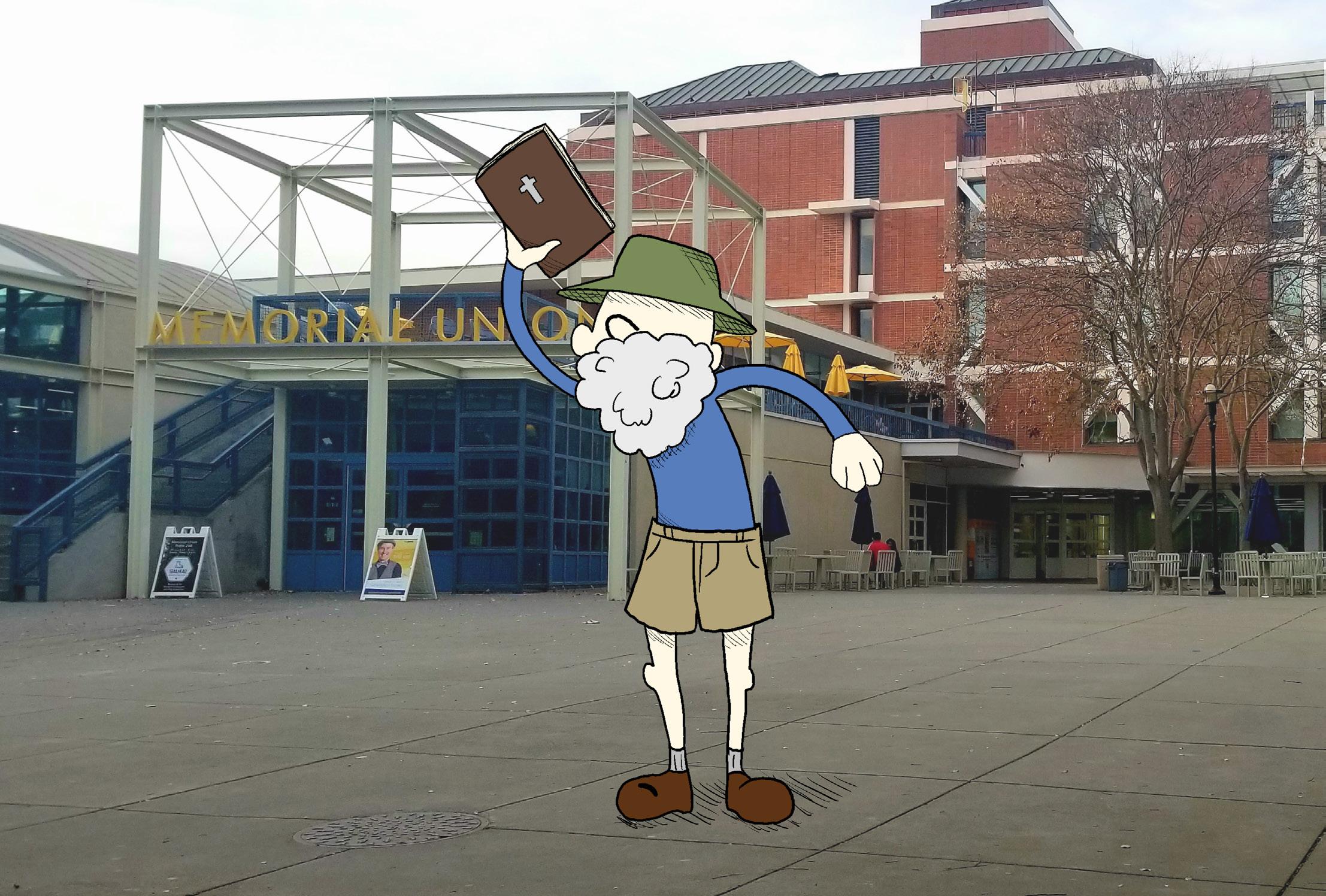
“NO ONE IS HERE ON CAMPUS OLD MAN.” S**t. I’m really gonna get it now. I gripped my bag of groceries closer to me. If I’m going to get my a*s beat, I can still save a pear or two from bruising. I brace for impact.
But no strike comes. No yelling. I look up to see his glassy stare is gone. He’s looking around the Quad.
“Everyone’s…” His eyes dart back and forth across campus. “Gone...” From deep within his chest, he starts shaking. “Everyone’s gone! Everyone’s GONE! EVERYONE’S GONE!” His head tilts downward.
“I’m FREE!” he shouts. His signature hat explodes into stardust. His clothes change color. What were once a grey coat and blue jeans have become bright red, orange and yellow swirls in a cloak he now wears. His long beard is still intact.
“You’ve set me free, boy!” he says, slapping me on the back. His eyes are wild with happiness.
“Because of a curse, I was doomed to preach here as long as there were students to hassle! Now, with no students on campus, I’m free!” He lights a cigar and inhales deeply.
“H-hey,” I stutter. “Aren’t preachers not supposed to s-smoke?”
“That preacher s**t was all part of the curse, my boy!” He produces a flask from his cloak and begins drinking heavily. He offers it to me and I nervously decline.
“Say, you wanna hit up a casino? A young man like yourself has gotta know where we can hit a place like that!”
“I don’t think that I—”
“Better yet, we’ll just fly there ourselves!” He bends his legs and straightens his hips.
“E-X-C-E-L-S-I-O-R!” he cries, and he explodes into the sky toward Sacramento, leaving a rainbow in his wake.
I sat there, gazing in awe. Then, one by one I picked up my fruits and put them in my bag. I walked home.
That week, I wrote my column at the Aggie on grain subsidies in South Africa. I mean, c’mon. Who would believe this other s**t?







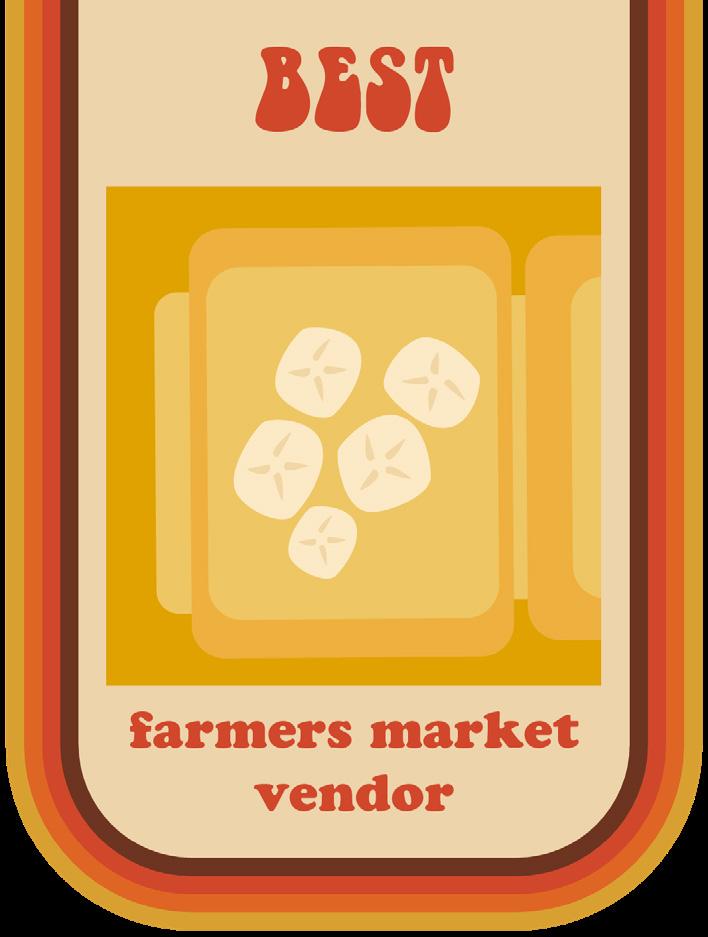
BY SOPHIE DEWEES features@theaggie.org
On a Saturday morning in Downtown Davis, it’s hard to miss the large white tents and long aisle of stalls adjacent to Central Park. The Farmers Market, a beloved City of Davis institution established over 40 years ago, is normally frequented by university students and locals alike. Although many students have returned home, the market continues to provide fresh produce, hand-crafted treats, home-baked goods and more.
According to Randi MacNear, the executive director of the Davis Farmers Market, staying open is essential, as the market functions as more than just a source of food for the community.
“The Farmers Market is like family to people,” MacNear said. “We’re really happy to be open, not just because the food is so amazing but because I think it really nourishes people at this time, both emotionally and physically.”
For UC Davis students, a particular favorite of the market is The Dumpling House. The establishment started as a local restaurant, serving customers for eight years, until it closed for repairs in 2018. That same year, they began offering dumplings at their new Farmers Market booth.
“They have a huge following and people were really happy that they could find them at the market,” MacNear said.
Linda Liu, the owner of The Dumping House, enjoys selling at the market because it provides greater community interaction.
“We like it because we meet a lot of local people,” Liu said. “People like the hand-wrapped dumplings.”
The high-quality dumplings are made with a special recipe and source ingredients for their fillings from the Farmers Market. The Dumpling House also sells dumplings both fresh and frozen with UC Davis students in mind. Dumpling House can be found selling their popular dumplings at the Farmers Market at Central Park. (Photo by Justin Han / Aggie)
BY ANJINI VENUGOPAL features@theaggie.org
Everything about Picnic Day seems quintessentially Davis — from cow milking to the Doxie Derby and the parade to beyond, the event is a favorite for students, faculty, alumni and members of the community alike. In light of the ongoing COVID-19 pandemic, this year’s Picnic Day was canceled on March 14, but the board worked to produce a virtual Picnic Day.
The event is especially meaningful to fourthyear statistics major and Picnic Day chair Nicole Deacon, who said her decision to attend UC Davis was largely influenced by attending Picnic Day as a senior in high school. Deacon didn’t attend Decision Day that year but had visited Downtown Davis, usually to pick up ice cream on the way back from visiting grandparents.

Picnic Day beats CoHo by just over 5%
BEST ASUCD UNIT: PICNIC DAY

“Picnic Day was the first time I had been to campus since I was accepted,” Deacon said. “We took the train and we got off the train at the same time the parade was going through downtown and it was just really cool.”
It was as she made her way onto campus, not really knowing where she was going, that Deacon knew UC Davis was the school for her — and that she needed to be involved with Picnic Day, in some way.
The first Picnic Day was held in 1909 to welcome about 2,000 attendants to view the new Dairy Farm, but the event was only called Picnic Day starting in 1916. In its 111 year history, this year marked the sixth ever cancellation — with prior cancellations due to World War II, an outbreak of hoof-and-mouth disease and gym conPicnic Day was voted as the best ASUCD unit. (Photo by Justin Han / Aggie)
“We sell frozen dumplings for students that don’t have time,” Liu said. “They can cook at home.”
Whether she’s making them for the Farmers Market or a holiday with her family, Liu’s love of dumplings started at a young age when she learned to cook from her grandmother. Now a grandmother herself, she makes dumplings for her six grandchildren.
“I make dumplings at home that I bring to my grandkids,” Liu said. “They all love my dumplings.”
Although The Dumpling House, like many other businesses, has been struggling due to the pandemic, Liu is hopeful and looks forward to the students returning to campus.
“We hope we can open as soon as we can to serve dumplings to the UC Davis students,” Liu said.
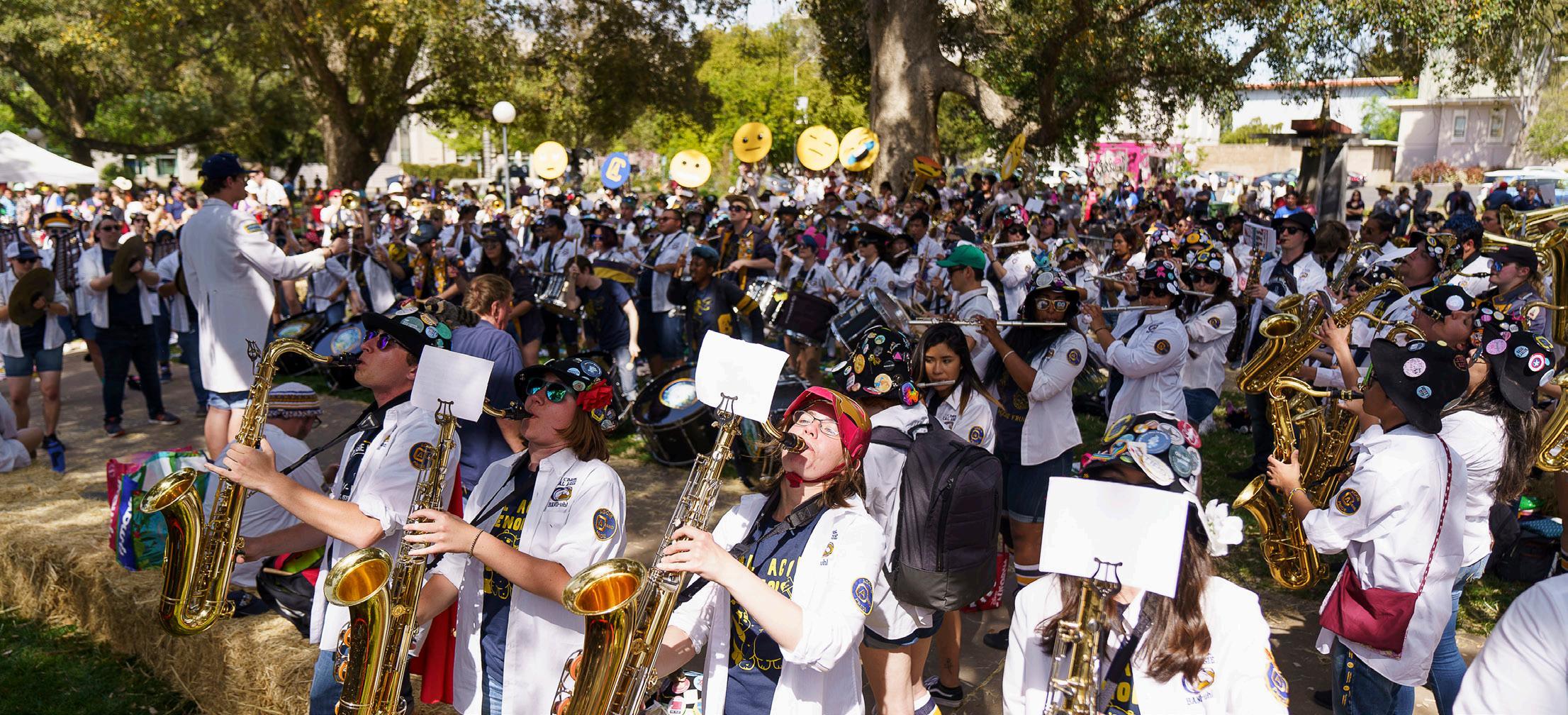
Although Davis’ culinary offerings are vast and varied, UC Davis students have voted Burgers and Brew as the best place in the city to take your parents.
Located on 403 3rd Street and normally open from 11 a.m to 10 p.m, the restaurant offers a number of burger options, ranging from hamburgers to garden burgers to chili cheeseburgers and more. The restaurant is known for offering a wide variety of specialty items, such as their turkey avocado melt, fish & chips and steak sandwich, as well as a number of specialty fries, including their Breakfast Fries with bacon and a fried egg, their New England Fries with jack cheese and clam chowder and their Gladiator Fries with grilled chicken, feta cheese and Caesar dressing.
Restaurant offers numerous burger options as well as specialty entrée, fries
BEST PLACE TO TAKE YOUR PARENTS: BURGERS AND BREW
BY SHRADDHA JHINGAN features@theaggie.org
Dr. Glen Fox, a professor of malting and brewing science, commented on the establishment’s “positive and helpful staff,” saying via email that there is always good service.
“I enjoy the food and beer options, [and] the service is quick,” Fox said. Burger’s and Brew on 3rd Street in Downtown Davis. (Aggie Files)
struction. This year’s virtual event was attended by about 5,400 people, a number of whom rejoined multiple times throughout the day. Picnic Day shirts were sold, with nearly $3,000 raised for the UC Davis Medical Center COVID-19 Support Fund, a success Deacon is extremely proud of.
Deacon was slightly surprised that Picnic Day won in this category, as she thought it would be classified as an event. But she said she thinks it makes sense — Picnic Day is dear to many.
“I am a little surprised, but I think this just shows how much [Picnic Day] actually means to the campus,” Deacon said. “Everybody knows what Picnic Day is, everybody enjoys it and it’s just the one thing and one day that everyone who goes to UC Davis really looks forward to. And it’s really special and unique to our campus and to the City of Davis.”
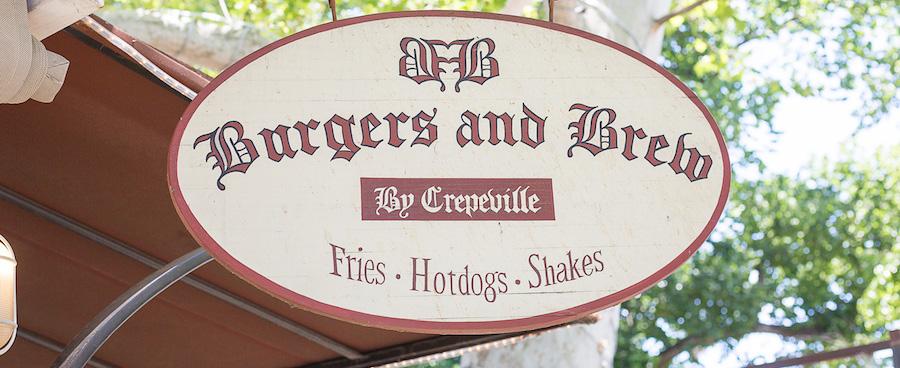
Burgers and Brew was first opened 15 years ago by two brothers “who wanted craft brew and a solid burger made with 100% Niman Ranch meats, and the freshest ingredients,” according to the restaurant’s website. Now, Burgers and Brew has five different locations in Northern California, including in Sacramento, West Sacramento, Chico and Davis.
Whether you’re looking for a place to bring your parents or are simply seeking a good restaurant, Burgers and Brew has good customer service and a wide variety of food choices that are likely to please students and their families.
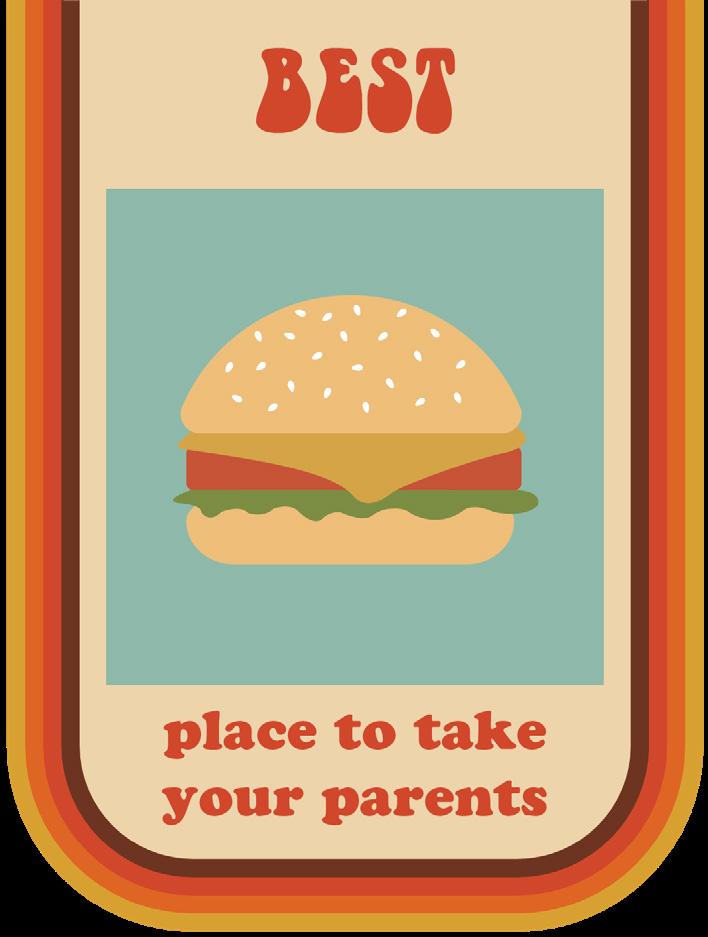
BY CLAIRE DODD features@theaggie.org
A debate practically as old as time in the Davis community: the fight over the best breakfast burrito. While there are more than a few contenders in the town, the real battle comes down to two establishments: Ali Baba’s and 3rd and U Cafe.
These two restaurants have close to a cult following when it comes to their respective customer bases, and I personally have experienced more than a few passionate debates over the subject. Thus, to settle the debate, The California Aggie asked readers their opinions and
Davis patrons have spoken: Ali Baba received 82.2% of votes, with 3rd and U taking 17.8% of the vote. This isn’t the first time the Middle Eastern fusion restaurant has won the title of best breakfast burrito — in 2018 it was also named the winner.
Ali Baba has been serving the Davis community since 1986, and it is widely regarded as a staple among both UC Davis students and Davis residents. Its menu offers customers two selections for breakfast burrito: regular and vegetarBreakfast burritos from Ali Baba. (Photo by Justin Han / Aggie)
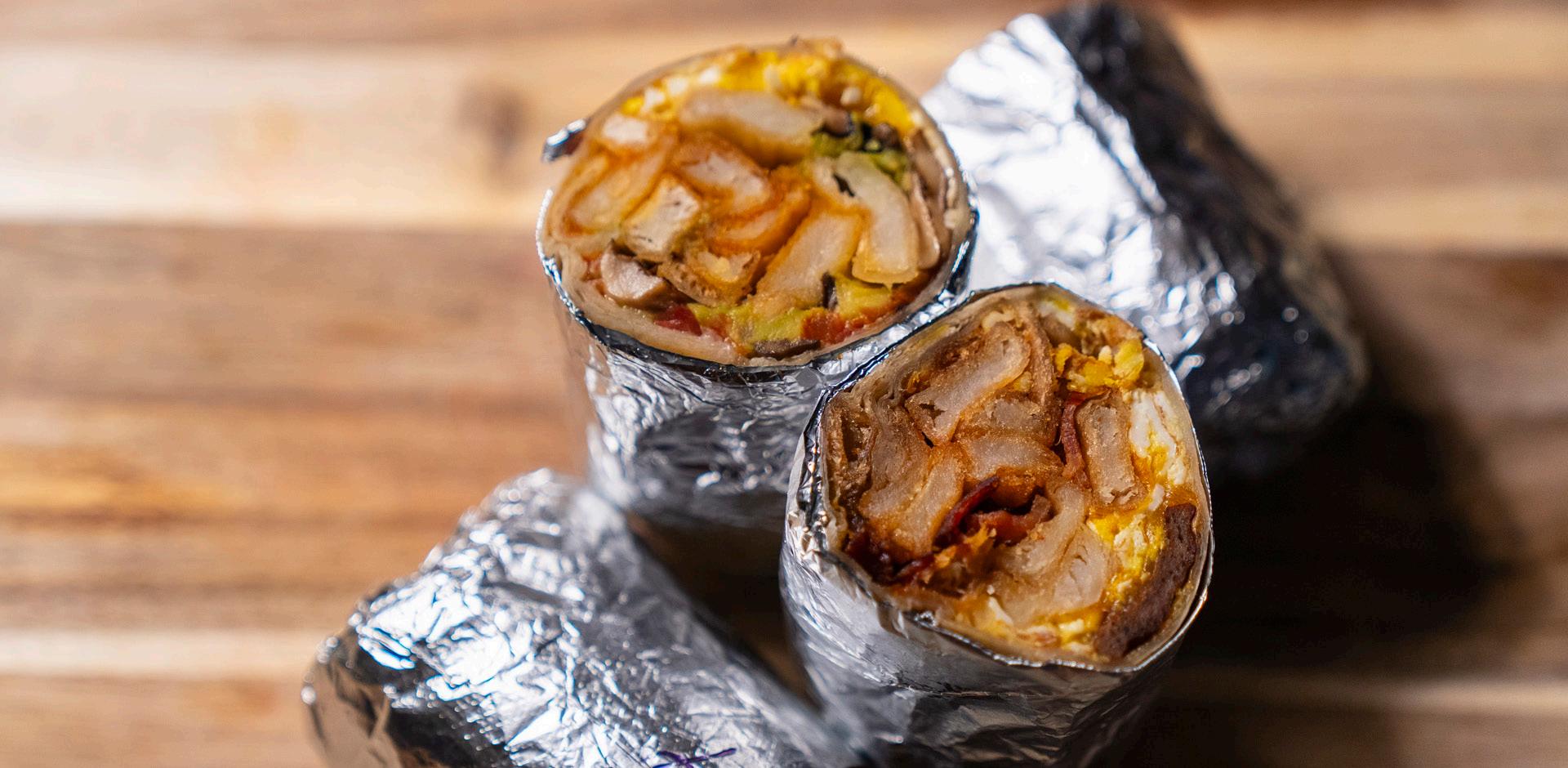
ian.
The ingredients the establishment uses aren’t necessarily typical — the regular burrito features eggs, bacon, beef gyro, cheese, french fries, honey and tapatio. The veggie option includes eggs, onions, tomatoes, mushrooms, avocado, french fries, honey and tapatio.
Ali Moghaddam, who took over ownership of the restaurant in June of 2008, emphasized his love and gratitude for the Davis community — especially in a time where the COVID-19 pandemic has hurt local businesses practically everywhere.
“We are thankful for the people in Davis who have voted us number one, and as far as these days — everybody is suffering,” Moghaddam said. “I’m really thankful for our customers for still keeping us afloat.”
The burritos are not only a fan favorite because of their unique flavors — the servings are also hearty, and the service remains unmatched. Courtney VanWinkle, a fourth-year environmental policy analysis and planning major, said she supports Ali Baba for myriad reasons.
“It’s really about the whole experience,” VanWinkle said. “The people are so nice, the portions are generous and it’s just a classic Davis staple.”
It’s no surprise that the eatery that won “Best Breakfast Burrito” also won the title of “Best Hangover Food.” Ali Baba won the title with 33% of votes, with Crepeville and and Black Bear Diner coming in at a close second and third,
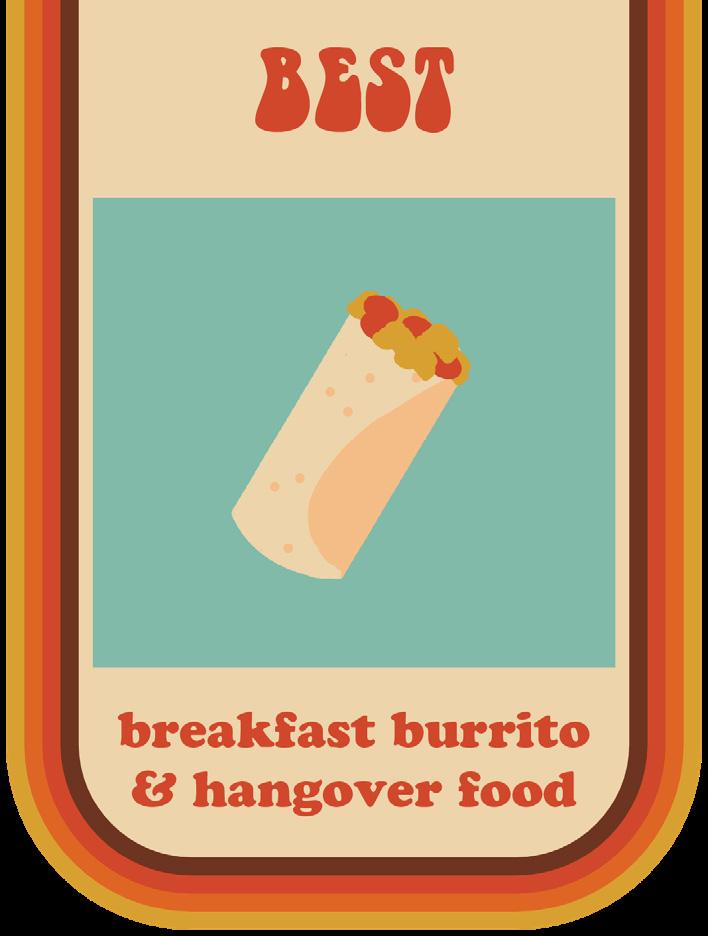
Taqueria Guadalajara, better known as Guad’s to Davis locals, is this year’s winner for Best Tacos in Davis, offering delicious and affordable Mexican cuisine that draws UC Davis students and local residents alike. The taqueria — which has locations in North Davis, South Davis and Woodland — serves an array of Mexican dishes including burritos, tostadas and quesadillas. Its award-winning tacos are plated with a generous serving of meat, fresh cilantro and onions. They start at just under $2 a piece.
BEST TACOS IN DAVIS: TAQUERIA GUADALAJARA
BY MADELEINE PAYNE features@theaggie.org
No matter the order, Guad’s regularly brings together groups of Davis students to connect Taqueria Guadalajara on Anderson Boulevard. (Aggie Files)
earning 26.7% and 21.4% of votes, respectively.
Despite the current pandemic, Ali Baba is still open for takeout. Hungry customers looking for a taste of the “Best Breakfast Burrito” in town can call the restaurant at (530) 758-2251 or place an order on its website.
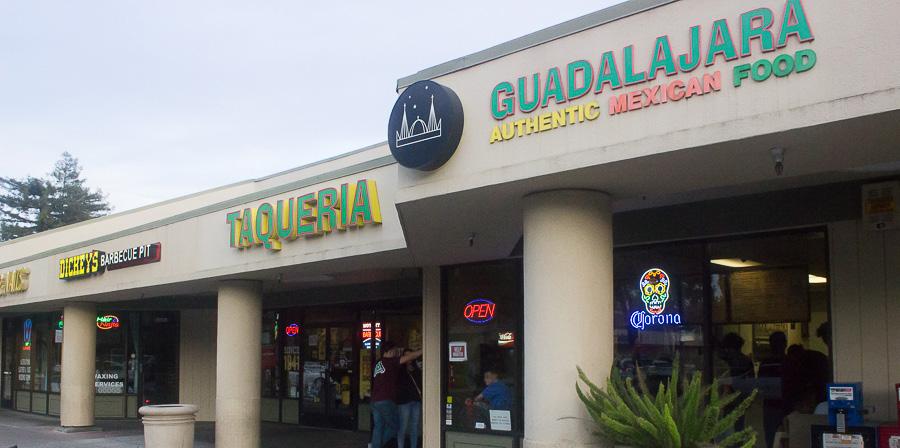
“The best snack on campus” BEST COHO BAKED GOOD: RICE KRISPIE TREAT
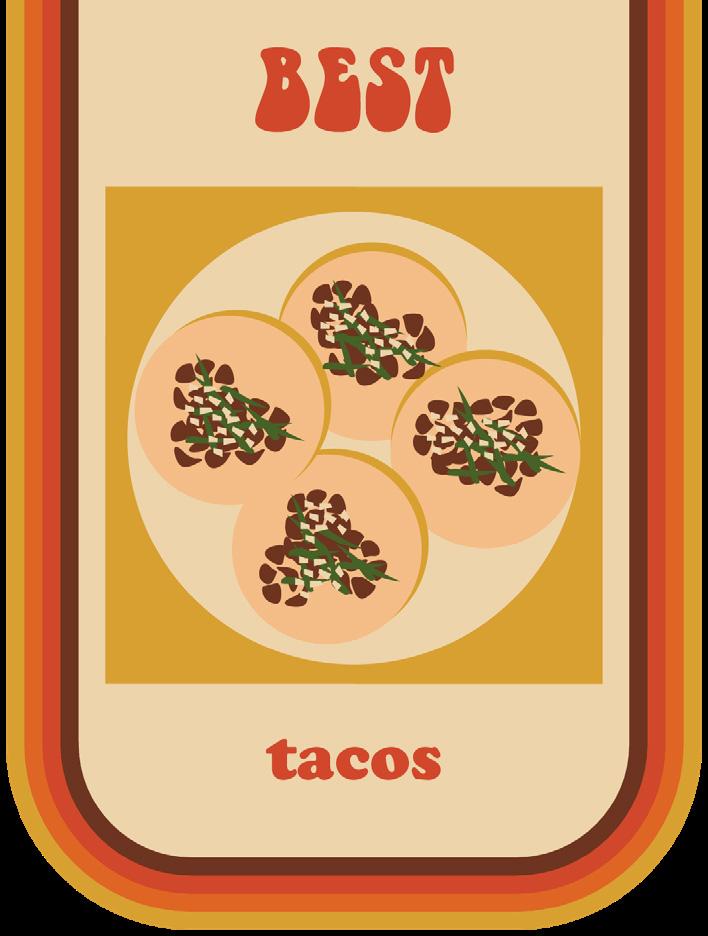
Sweet, airy, chewy and lip-smackingly tasty: That’s the CoHo Rice Krispie Treat.
This year, 26.6% of voters ranked this notso-baked good the best baked good at the CoHo. The classic combination of Kellog’s Rice Krispies cereal, ooey gooey marshmallow and butter may be simple, but the size, ingredient ratio and texture of CoHo’s version makes this a cult favorite among Davis students. The coffee cake deserves a quick shout out, too, which came in as 26.2% of voters’ favorite CoHo goody.
BY ALLIE BAILEY features@theaggie.org
There’s debate over the true origins of the Rice Krispie Treat, and despite some brands offering similar sweet puffed rice snacks prior to the Kellogg recipe release in 1940, two women in a Kellogg kitchen in Michigan were the first (documented) to use marshmallow as the binding agent for the cereal. The recipe they coined that we see today on the side of the bright blue cereal box has never been changed — don’t fix what ain’t broke, as they say.
The unique rise of the treat as a recipe recommendation is perhaps why the unique concoction Swirlz at the CoHo operating during Fall Quarter 2019. (Photo by Justin Han / Aggie)
over a quick take-out dinner or a dine-in meal. Jeremy Inducil, a second-year mechanical engineering major at UC Davis whose go-to order is a super burrito with carnitas, said he loves Guad’s for the way it fosters community.
“It epitomizes the Davis environment,” Inducil said. “A bunch of young college students having fun — eating delicious, affordable food.”
Ayush Garg, a second-year computer science and cognitive science double major at UC Davis, has a go-to order: a veggie burrito. Garg echoed the sentiment that Guad’s is a great option for Mexican food for UC Davis students.
“Guad’s is the perfect college cuisine because it’s extremely affordable, packed with flavor and it has very fast service,” Garg said. “Also, it has one of the best salsa bars I’ve seen at a taqueria.”
He added that it provides a sense of comfort during the school year.
“There’s something about being in college that makes [Guad’s] feel very homely,” Garg said.
Guad’s is remaining open for take-out orders during the shelter-in-place order.
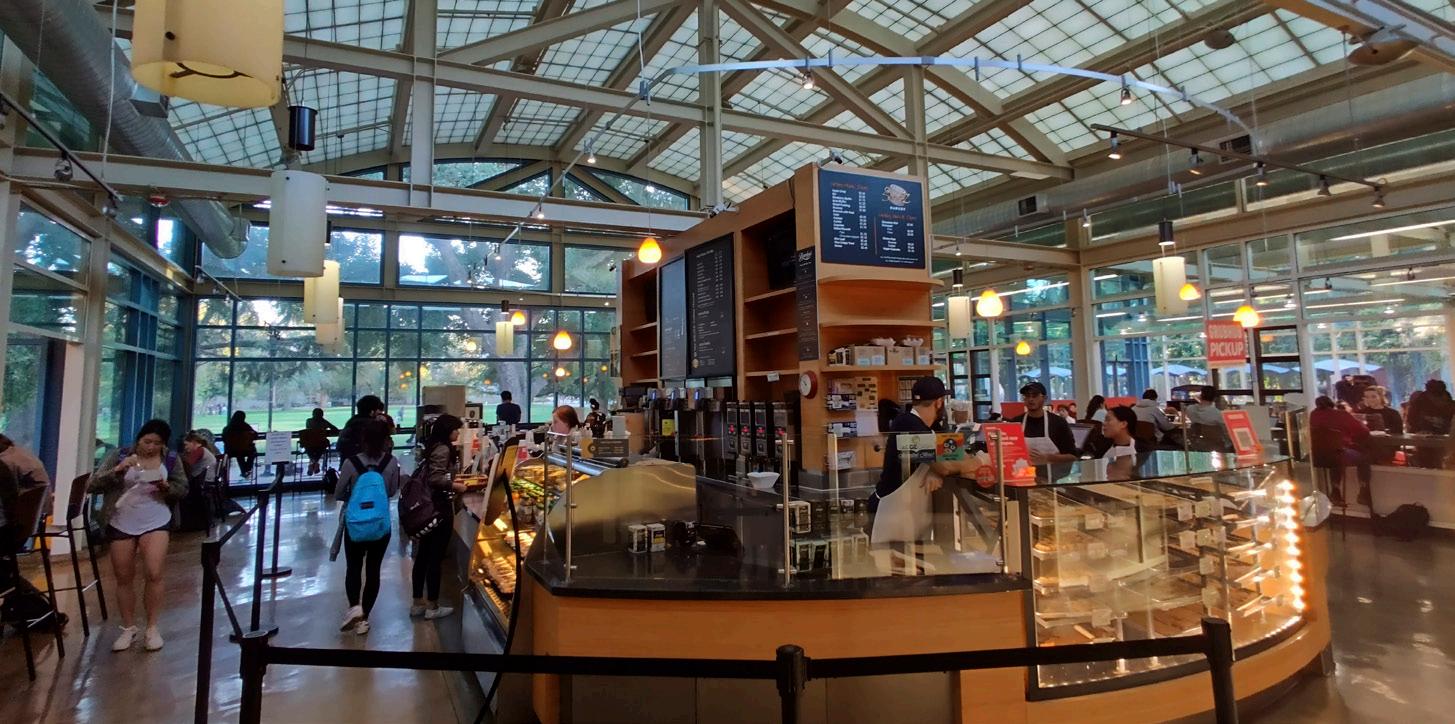
Southwestern Tex-Mex option serves greatest “bang for your buck”
BEST COHO VENUE: TXMX
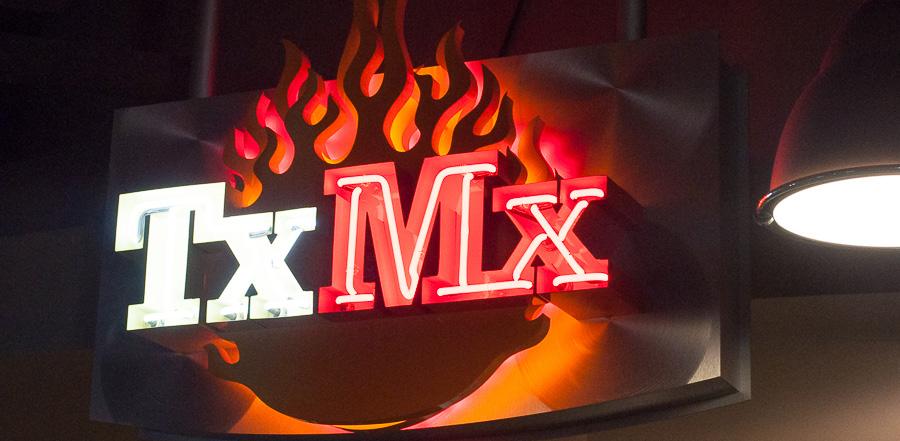
BY CAROLINE RUTTEN features@theaggie.org
At the CoHo, located centrally on campus by the MU and the Quad, it is not uncommon to see students rushing to their favorite choices to beat the crowd before rushing off to their next class. With a variety of options, from bagels, salads, sushi and more, one option reigns supreme: TxMx. Winning 27.9% of the vote, with the Fickle Pickle’s sandwiches coming in a close second at 23.1%, it is clear that this Southwestern Tex-Mex restaurant is a UC Davis favorite.
For second-year managerial economics major Isabelle Zuroske, there are a variety of reasons to love TxMx.
“I really like the taste of it, the guacamole is pretty good,” Zuroske said. “I also really like the tortillas; they are warmed which makes it a lot better. Also, the cheese is always melted on the burritos.”
Besides the taste of the food, she considers it to be the CoHo with the best “bang for your TxMx is one of the several food vendors in the CoHo. (Aggie Files)
has become a bake sale and coffee shop essential; civilians were making them at home for years before the (inferior) name-brand variant of the treat saw the supermarket shelves.
With most Rice Krispie Treat production being homemade, it’s no surprise that the quality of the texturally-satisfying sweet varies across establishments offering their own version. The CoHo’s take on the classic lies on the high end of that scale. As a frequent Rice Krispie Treat consumer myself, I can say that they are some of the best I’ve ever tasted. And fellow students obviously agree.
“I’m all about the Rice Krispies at the CoHo,” said Bea Paolucci, a fourth-year agriculture and environmental education and Italian double major. “I really miss them. Not only are they huge, they are the perfect balance of marshmallow and cereal. They are strong and don’t fall apart when you eat them. They are the best snack on campus.” “The best snack on campus” is quite the statement. It seems these treats truly have something special about them.
For Nina Price, a second-year civil engineering major, it’s more than something special; the crisped rice snack is psychologically manipulative.
“The Rice Krispie Treats from the CoHo are irresistible,” Price said. “I’ve pavloved myself into craving one with every cup of coffee.”
That’s one way to run out of grocery mon
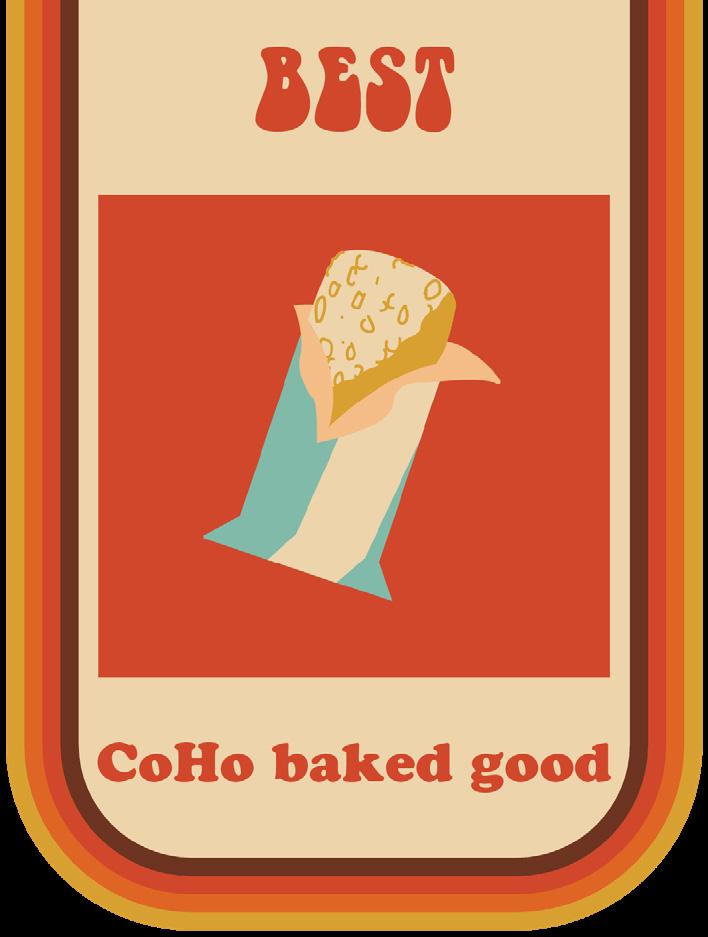
buck.”
“It’s really good food, but the price is perfect,” Zuroske said. “If you go to the salad place, you have to spend $10 for a really good salad. But you can get a rice, bean, cheese burrito for $3 or a California burrito for $7.”
Zuroske likes TxMx because she knows she will always be filled up with enough energy for the rest of her day without breaking the bank. She does not, however, leave feeling overly stuffed, noting she can still feel full with lighter options.
“The California burrito is my go-to,” Zuroske said. “But if I don’t want something quite as heavy, I’ll go for a taco bowl. They still come with a lot of food and they are still filling. I like how they always give out apples too. It’s perfect; you can have a more balanced meal.”
Zuroske usually visits TxMx twice a week, depending on how often she is on campus. Although she anticipates a long line of other TxMx fans, she continues to keep coming back to her favorite CoHo restaurant.
“There is almost always a line during lunch hour,” Zuroske said. “I make sure I have an hour between classes, and I will devour my burrito in the CoHo. The line is long; you have to stand there for 20 minutes to get your food, but it’s worth it for me.”
ey. It’s not clear whether this was an intentional experiment on herself or a trick played by the CoHo to which she fell victim.
Either way, one thing’s for sure: These treats are the real deal, and if you haven’t tried them yet, do yourself a favor and cop a couple from the CoHo.

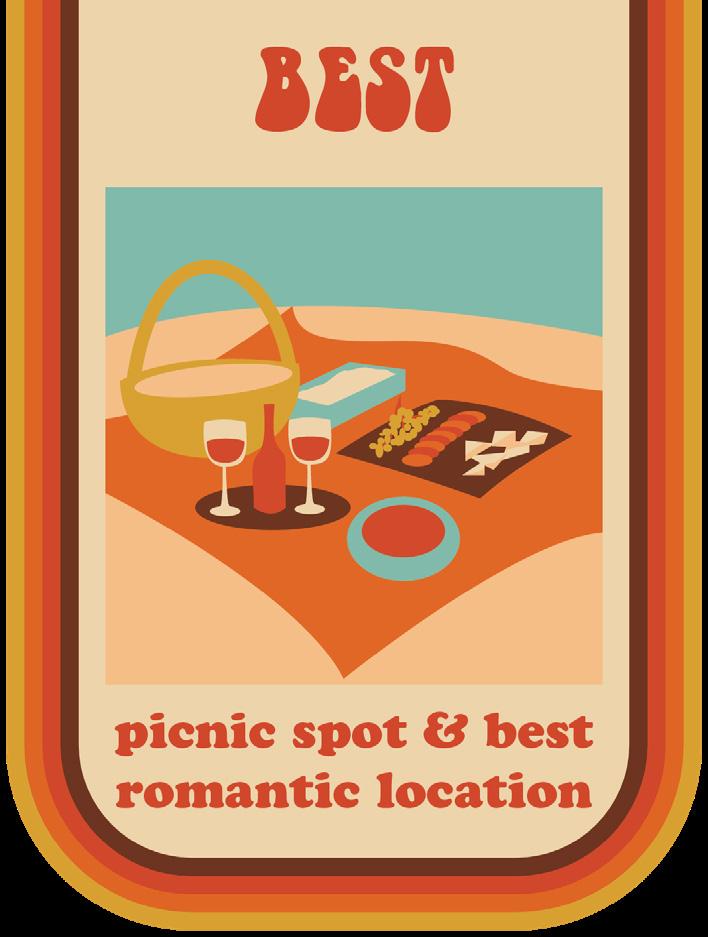
BY NORA FARAHDEL features@theaggie.org
With its serene and earthy atmosphere, filled with a plethora of nature and wildlife, the Arboretum shines through as a favorite spot on campus. Voted as both Best Picnic Spot and Best Romantic Location this year, the Arboretum is a place of relaxation for many, and an escape from the hustle of campus life. Here, you can sit on the grass, admire the beautiful water and friendly ducks and truly let go.
Naomi Rivas, a first-year history major, notes that, as a picnic spot, the Arboretum provides a place with shade where she can read a book or work on an assignment. At the same time, Rivas also enjoys going to the Arboretum with others. Rivas shared her experience at the Arboretum with a significant other, a happy memory that has stood the test of time.
“The first time I visited Davis with my boyfriend, we sat down on a bench in the Arboretum and watched a family of ducks swim by in the water,” Rivas said. “Even though it’s been almost a year since we visited together, he still remembers how nice it was — and the family of ducks.”
What makes the Arboretum so special to students is the way it differs from the rest of campus. According to Bailey Cohen, a first-year animal science major, unlike the other bike-filled, noisy spots on campus, there is a feeling of tranquility at the Arboretum.
“I love the Arboretum because it’s such a peaceful area,” Cohen said. “You can go there to clear your mind, study or just hang out with friends. It’s nice to see nature so close by. There’s not as many people walking or biking and you can just sit by the water and look at the ducks People relaxing at the Arboretum during Fall Quarter 2019. (Photo by Justin Han / Aggie)
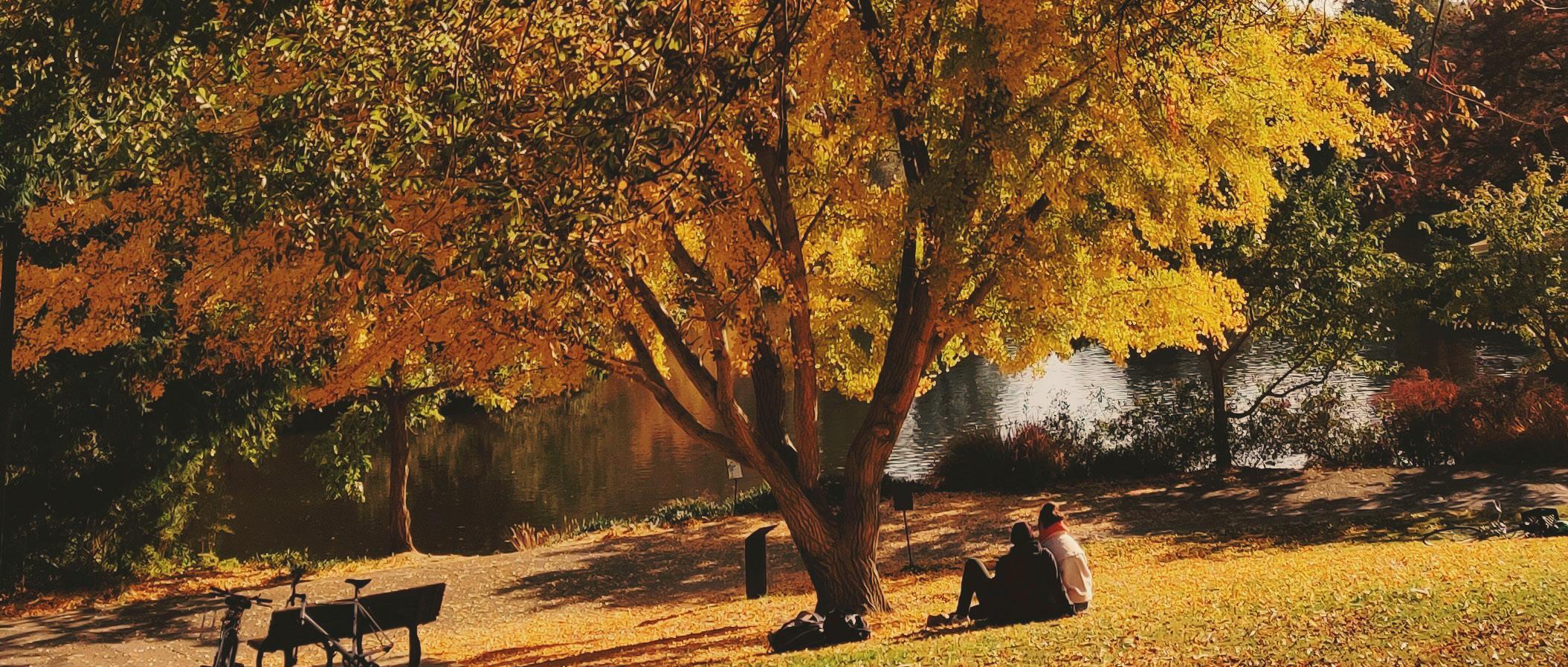
To the students who have been wandering around campus, searching endlessly for the mouth-watering scent of Middle Eastern cuisine that tends to drift around during lunchtime: It’s likely you find yourself in front of Shah’s Halal food truck. The local, family-run business has been a top food truck pick for students thanks to its variety of flavorful entrees geared toward both meat-eaters and vegetarians.
Shah’s is known far and wide for its two most popular entrees: gyros and rice platters with a choice of falafel, chicken or lamb. These dishes are lathered in spicy sauce and yogurt and topped with shredded lettuce. The line for Shah’s becomes notoriously long around 12pm, but third-year biochemistry major Kritika Sharma guarantees it’s worth the wait. Sharma is a regular at Shah’s Halal and often finds herself enjoying her hearty meal in the arboretum aftering picking up her order.
Middle Eastern cuisine is a fan favorite
BEST FOOD TRUCK: SHAH’S HALAL
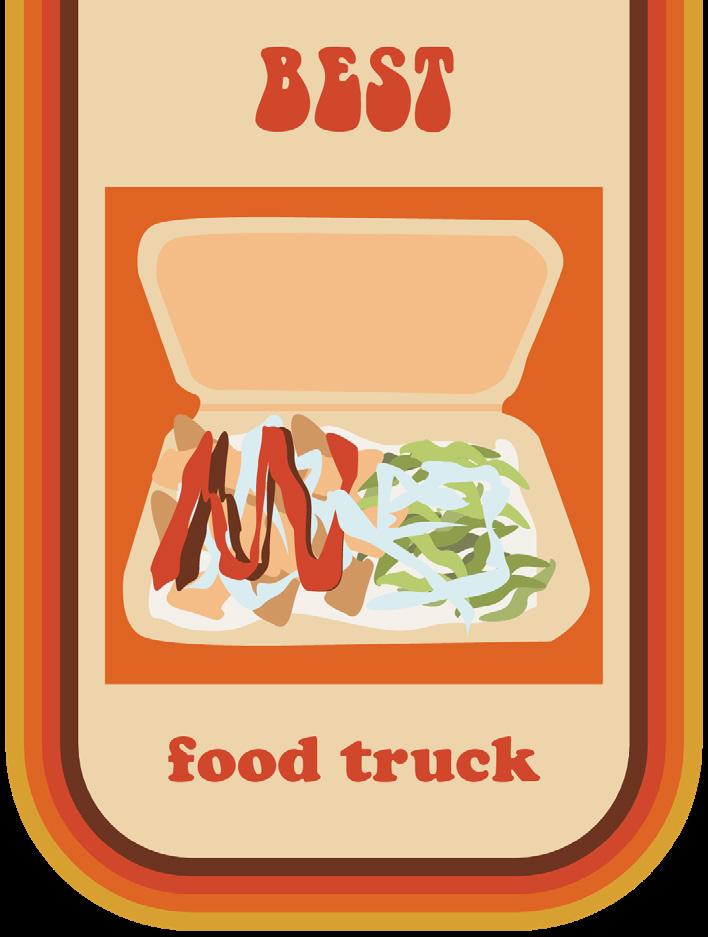
BY SNEHA RAMACHANDRAN features@theaggie.org
“Falafel over rice spicy is my go to order,” Sharma said. “It’s my favorite thing to eat, especially during Winter Quarter, because the combination of spice and flavor keeps me warm. I also find it harder to find savory vegetarian food, and Shah’s is one of the few eateries on campus that doesn’t just serve bland, steamed vegetables.”
The chicken gyro is third-year biochemistry major Venkat Uppalapati’s go-to order, especially after midterms.
“I usually get Shah’s after midterms as a sort A Shah’s Halal Food truck by the Silo on the UC Davis campus. (Photo by Quinn Spooner / Aggie).
and fish.”
Due to COVID-19, nature areas like the Arboretum have become more popular as an escape from quarantine and an opportunity for fresh air while social distancing. In a message posted in April, the Arboretum’s director Kathleen Socolofsky emphasized that while the Arboretum remains open, all visitors must follow social distancing guidelines.
Whether it’s to picnic or spend time with a significant other, the Arboretum provides a natural escape. For students like Rivas, it is an essential spot on campus.
“The trees and the little river make me feel like I’m in a different world,” Rivas said. “I like to think of it as a small escape from whatever I have going on where I can just enjoy nature, even if it’s only for a moment. It’s definitely part of the Aggie experience.”
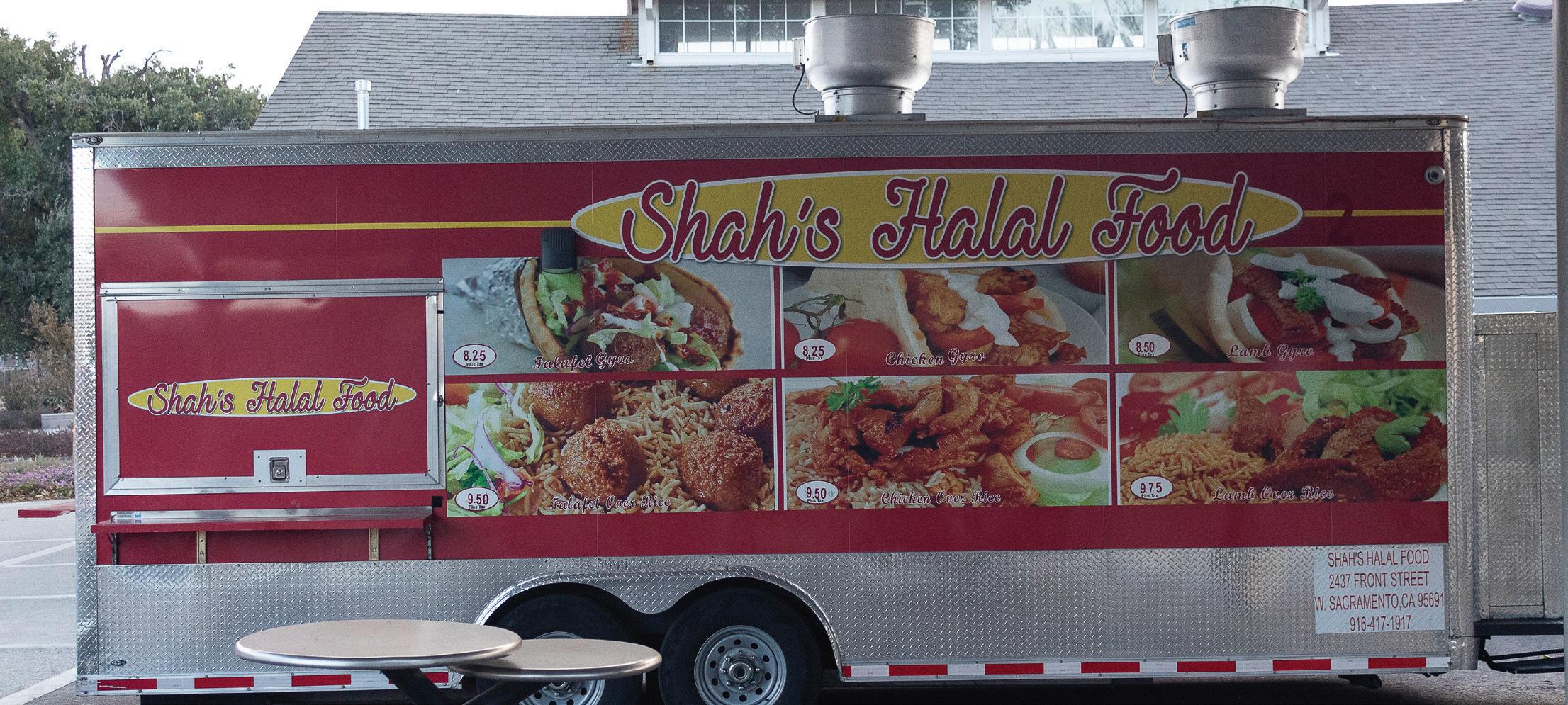
BY EDEN WINNIFORD features@theaggie.org
The results are in, and students named Yoloberry Yogurt as the best dessert place in Davis. Owner Lee Pflugraph credited the win to a mix of good vibes, tasty yogurt and friendly employees.
“It’s a good community gathering spot,” Pflugraph said. “We have 101 toppings and the highest quality yogurt. We have a fun atmosphere, and the employees are really nice.”
He explained that Yoloberry Yogurt is also an important event space for UC Davis student organizations, which host fundraisers and celebrations.
BEST DESSERT: YOLOBERRY YOGURT
“We have a lot of Greek Life come and a lot of the clubs,” Pflugraph said. “We sponsor a lot of fundraisers for groups on the campus, and I noticed some of the coaches of various sports bring their teams in.”
The local staple has been a beloved part of the community for 13 years, and it is no stranger to praise. Yoloberry Yogurt also won The Aggie’s Best of Davis in 2017, and the Davis Enterprise has awarded this dessert shop the Readers’ Choice Best Frozen Yogurt for 11 years in a row.
Yoloberry Yogurt’s website says the shop offers delicious yogurt at a reasonable price.
“Our products are made of the highest-quality ingredients, and we guarantee to only serve you with the freshest products available in Da- Yoloberry Yogurt sells frozen treats in all sorts of flavors. (Photo by Trevor Goodman / Aggie)
of reward,” Uppalapti said. “It’s nice because Shah’s is pretty affordable plus it comes with a drink so I definitely feel like I’m getting my money’s worth. Plus I feel like in Davis it’s hard to find good restaurants that fill my craving for spicy food, but I feel like Shah’s is definitely one of the few places that does.”
He also noted that even if patrons are opposed to spice, Shah’s will definitely leave you satisfied. Customers can customize spice to their liking, and even the most mild-food lovers will walk away feeling satiated.
Though food trucks on campus are currently closed due to COVID-19, those interested in trying the infamous Middle Eastern cuisine can find one of the joint’s trucks often parked in the University Mall parking lot, right next to Trader Joe’s.
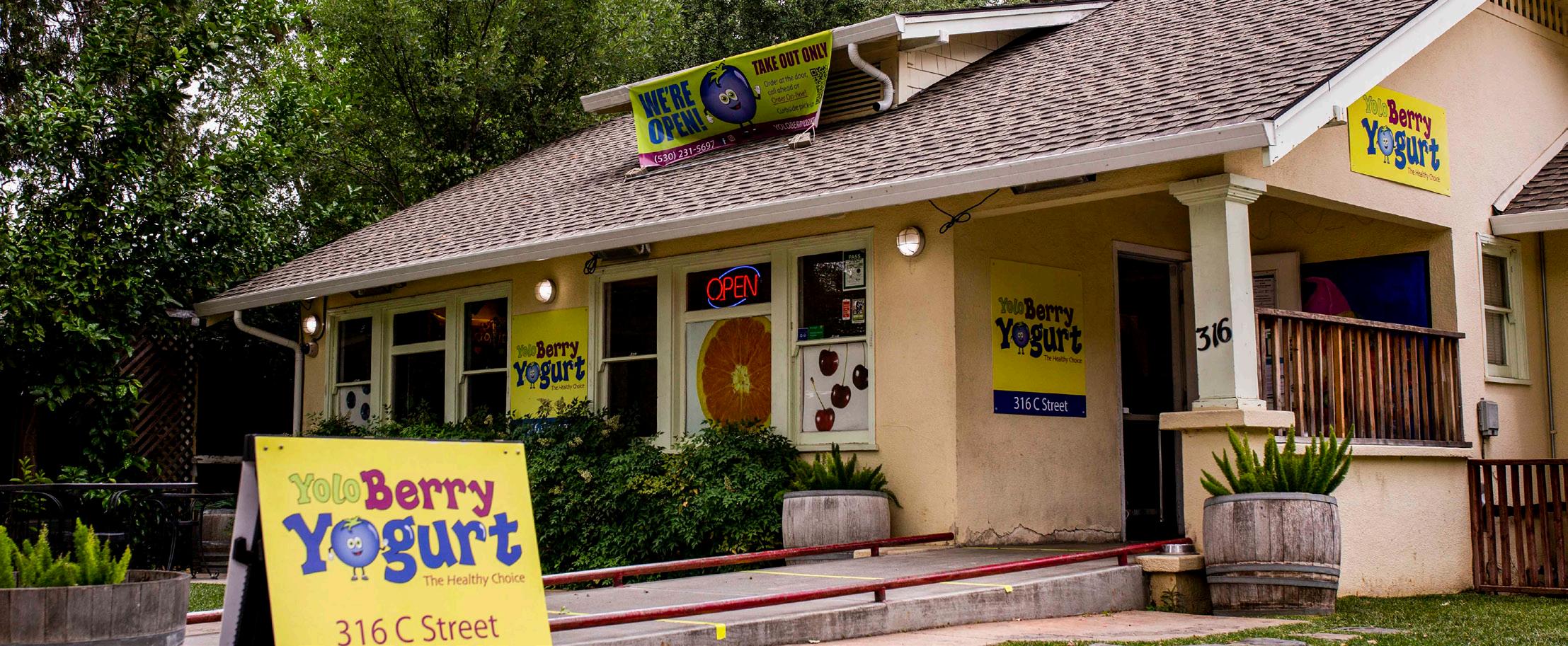
vis,” its website states. “Our prices are flexible and our yummy foodies will surely make you come back for more!”
Pflugraph added that along with its good environment, its central location and late-night hours make Yoloberry Yogurt a great place to hang out with friends.
“We have a great atmosphere, my staff is courteous and friendly,” Pflugraph said. “We have a good vibe going. There’s not a lot of latenight places to go if you’re under 21 in Davis, so it’s a good meeting place for people. A lot of people want to meet their friends here. Everybody knows about it, and it’s right across from Central Park — it’s a good meeting area.”
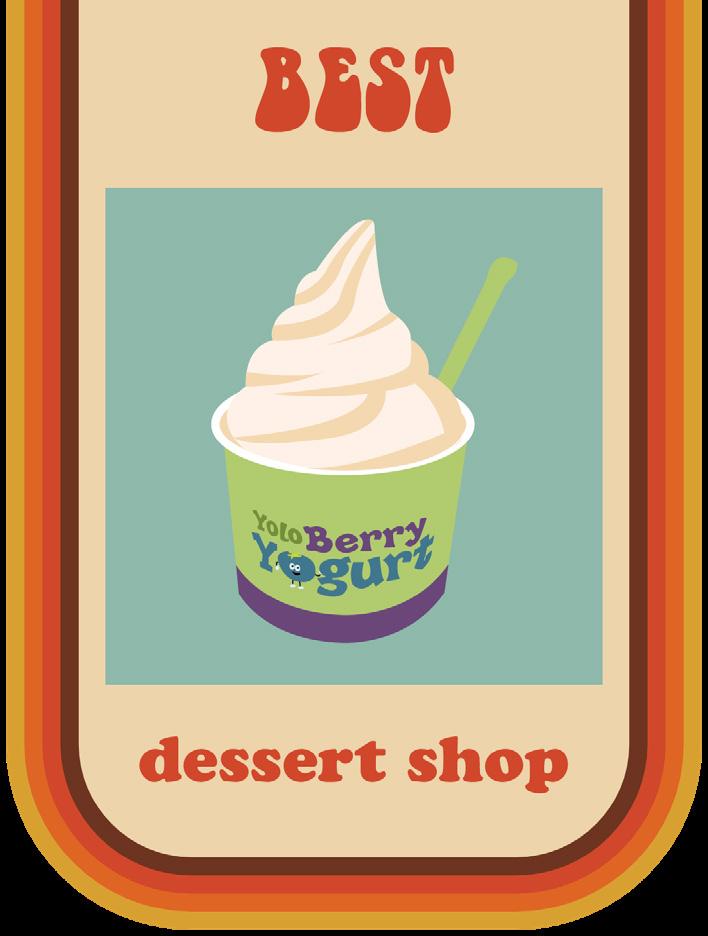
BY RAIN YEKIKIAN features@theaggie.org
The Student Community Center (SCC) is a valuable asset to the UC Davis campus and home to several student resource centers that provide a safe space for anybody looking to express themselves and meet new people.
The SCC features many different centers, such as the LGBTQIA Resource Center, the Cross Cultural Center and the Women’s Resources and Research Center, among others — all of which aim to educate and empower students from variThe Student Community Center on campus houses various resource centers (Photo by Quinn Spooner / Aggie)
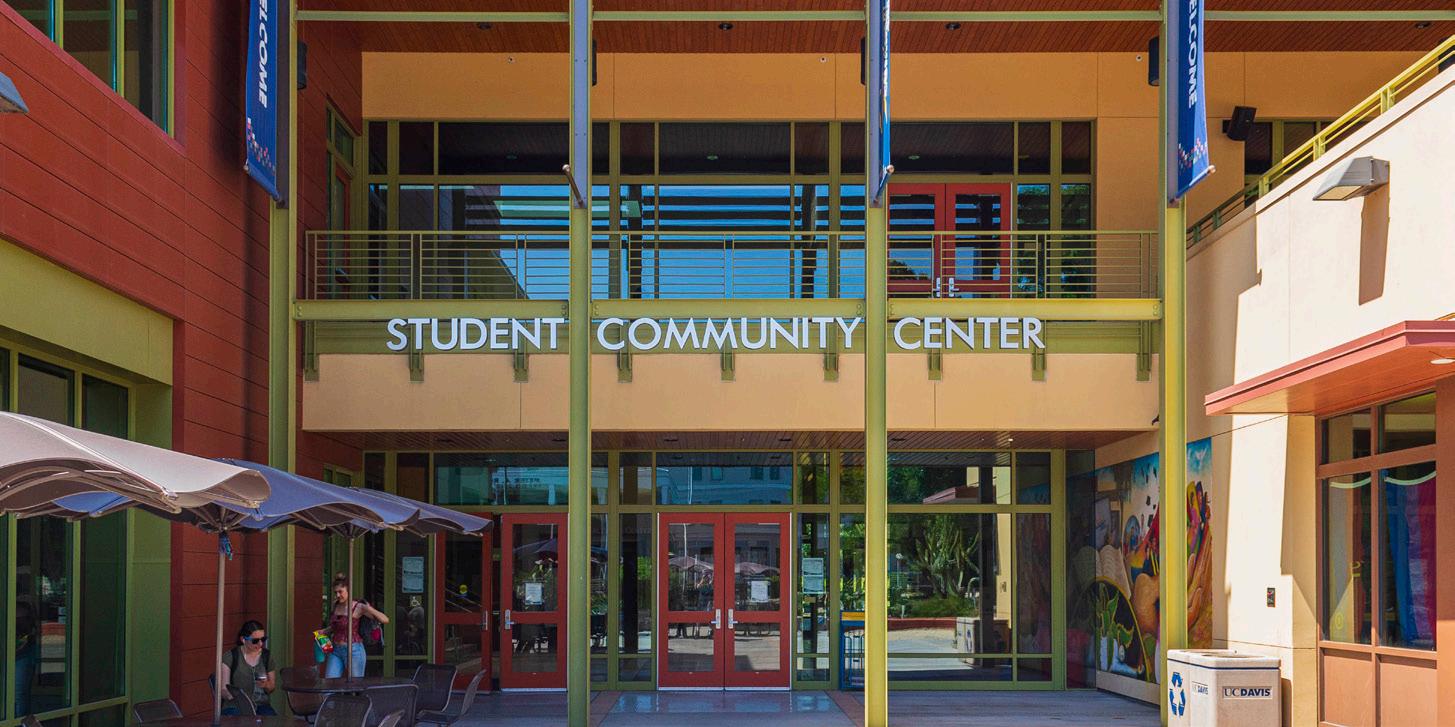
ous communities.
Third-year Spanish and gender, sexuality and women’s studies major Maggie Luque is appreciative of the SCC and each of the different services its centers provide.
“They all host social and educational events for people to further connect with their communities, make friends and learn,” Luque said. “I think that all of the community centers are indispensable and they all do important work to assess and address student needs.”
With two floors of seating and the CoHo
South Cafe on the first floor, the SCC also serves as a good place to study, especially for anyone who prefers to have food options available or some background noise while working.
The SCC also has several meeting rooms that are available for reservation by students, along with a computer room, which gives students access to computing and printing services.
Senior psychology major Brianna De Anda reflected on how the SCC can be a helpful resource. “As a transfer student, it was a great place besides the transfer center to meet new people,” De Anda said. “I loved that in one building there were places to study, eat, relax and that there were easily
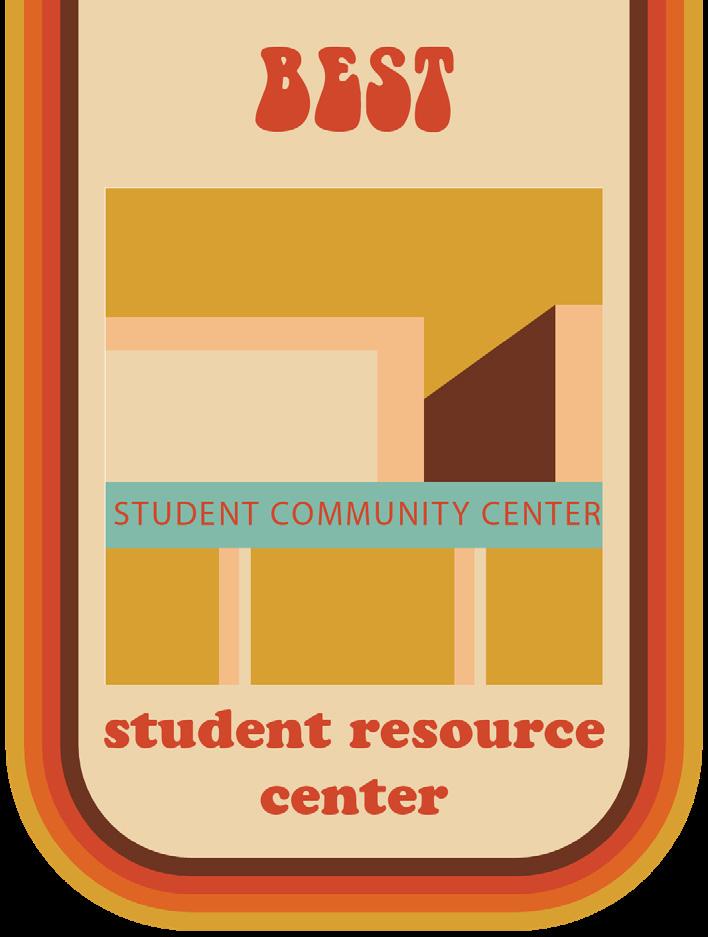
BY LIZ JACOBSON features@theaggie.org
The sunflower fields took home the gold(en yellow) as this year’s best photo shoot location, with 36.8% of the votes. The sunflower fields, located in and around Davis, narrowly beat the Arboretum for the top spot.
The sunflowers are only in bloom during the summer months, so now is the time to start breaking out the camera. Third-year managerial economics major Ashley Metcalfe visited the sunflower fields last July on a whim when driving from the Bay Area to Sacramento.
Sunflowers only in bloom during summer — so start breaking out the camera!
BEST PHOTO SHOOT LOCATION: SUNFLOWER FIELDS
“During the drive we passed acres of sunflowers along the highway,” Metcalfe said. “They were so beautiful, and it was the first time I saw them Sunflower fields south of Davis. (Photo by Justin Han / Aggie)
accessible resources like the LGBT+ center, the undergraduate research center and the women’s resource center. It really made the transition to living in Davis so much easier.”
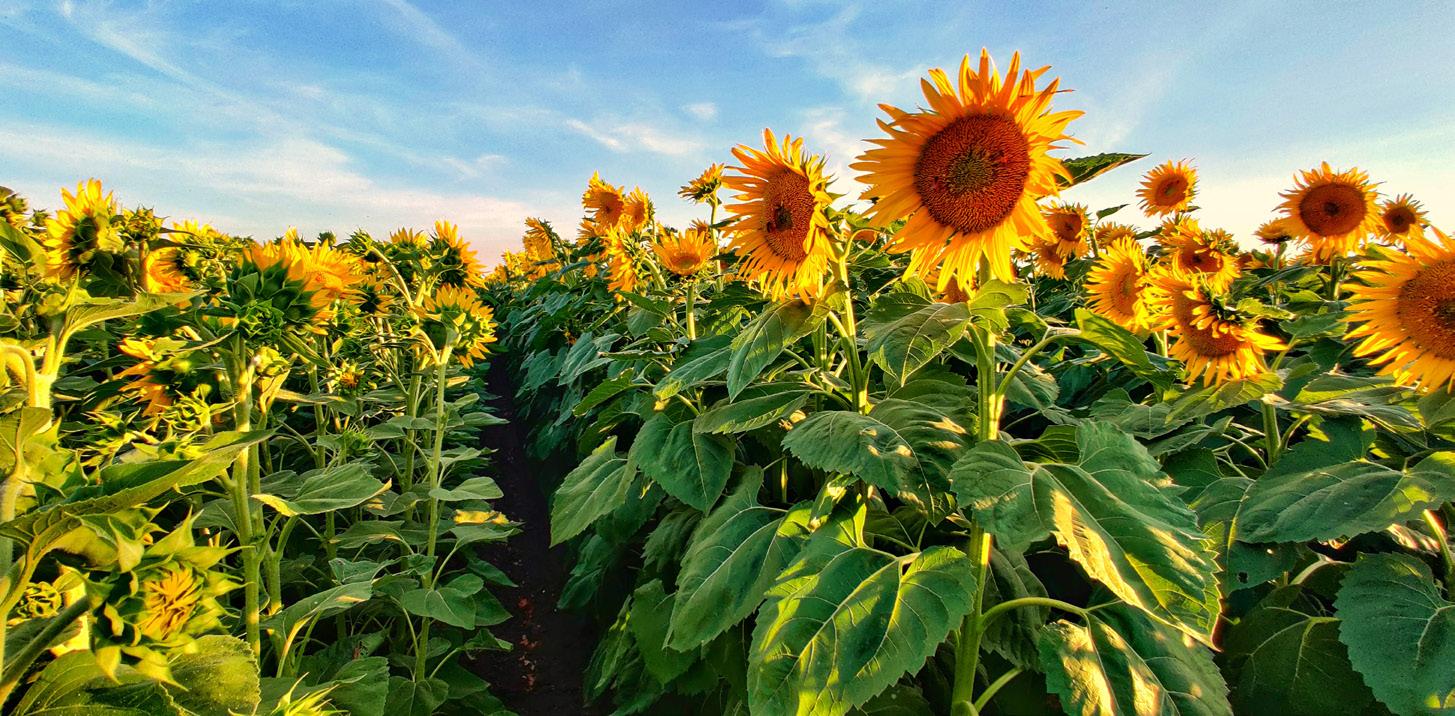
in person. Spontaneously, we decided to pull over at the 76 Gas Station in Dixon to take a few photos.”
The photos Metcalfe and her sister-in-law took that day are some of her favorite photos to date, and one of the pictures has been her Instagram profile picture for almost a year now.
“I loved how bright the photo was,” Metcalfe said. “I happened to wear a yellow shirt that day which wasn’t planned at all, but I really liked how it matched with the sunflowers.” Sunflowers are sure to make a splash on social media.
I definitely got some great photos of both myself and my friend,” said Annabel Collins, a third-year animal science major. “I posted one on Instagram and I got a ton of compliments on that particular post, most likely because the sunset in the background made the sky look rainbow-colored and the flowers looked super cool against it.”
Collins recommends waiting to go until later in the summer because that’s when the flowers are in their best bloom, as well as waiting until sunset to snap a picture or two. “That’s the best time to go because the lighting is less harsh and gives people the ‘golden hour’ look,” Collins said.
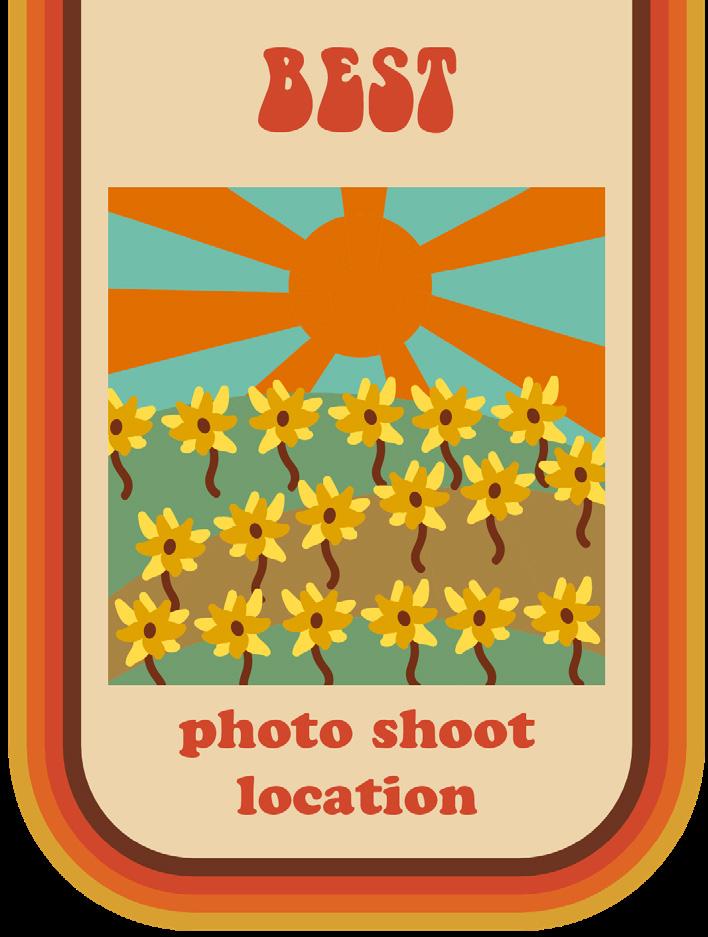
BY LYRA FARREL features@theaggie.org
The used clothing store Bohème in Downtown Davis often has residents and visitors ogling at its storefront, which is complete with shocking patterns, a vibrant outdoor display of tutus and Snoop Dogg prayer candles. The store sells most of its unique items for $6 to $12 and goes by the slogan “The Happiest Store in Davis.”
Bohème, located on 409 Third St., was started in the summer of 2012 by former owner Dawn Donahue, who noticed that Davis lacked a clothing store that followed the buy-sell-trade model. A few years later, the store was sold to the current owner, Yelena Ivashchenko, who was inspired by the idea of giving clothing a new life and crafted her own up-cycled additions to the store’s massively diverse selection.
Ivashchenko discussed how she currently operates her store while the curbside pickup rule is in effect.
Owner, employee of buy-sell-trade clothing store Bohème talk about why they love serving the community
BEST THRIFT STORE: BOHÈME
“If you need something, just let me know, you can call the store, you can message me, or you can just come by and say, ‘Hey, it’s getting hot, I need some shorts, I need size this, I [prefer these] colors,’” Ivashchenko said. “In the past, I looked through my inventory, I pulled out a few items, and as they came [up] I said ‘Hey, this will fit you, this will fit you, what would you like?’ And then we did it all distantly, and then she picked up two pairs of shorts and then processed the payment right there, and it’s done. So if people are willing to do that, that works great.” Audrey Salbacka, a Bohème employee and recent
UC Davis graduate, said there is new difficulty in helping customers find the fashion they otherwise would have been able to try on for themselves.
“We’ve been lucky enough to have a few sales through Instagram and Facebook, but it’s really hard to work with people to find something that Bohème thrift store on 3rd Street in Downtown Davis. (Photo by Trevor Goodman / Aggie)
For those that head to the fields at high noon, Metcalfe recommends bringing sunglasses and wearing an outfit that will complement the flowers — neutral colors are a safe bet.
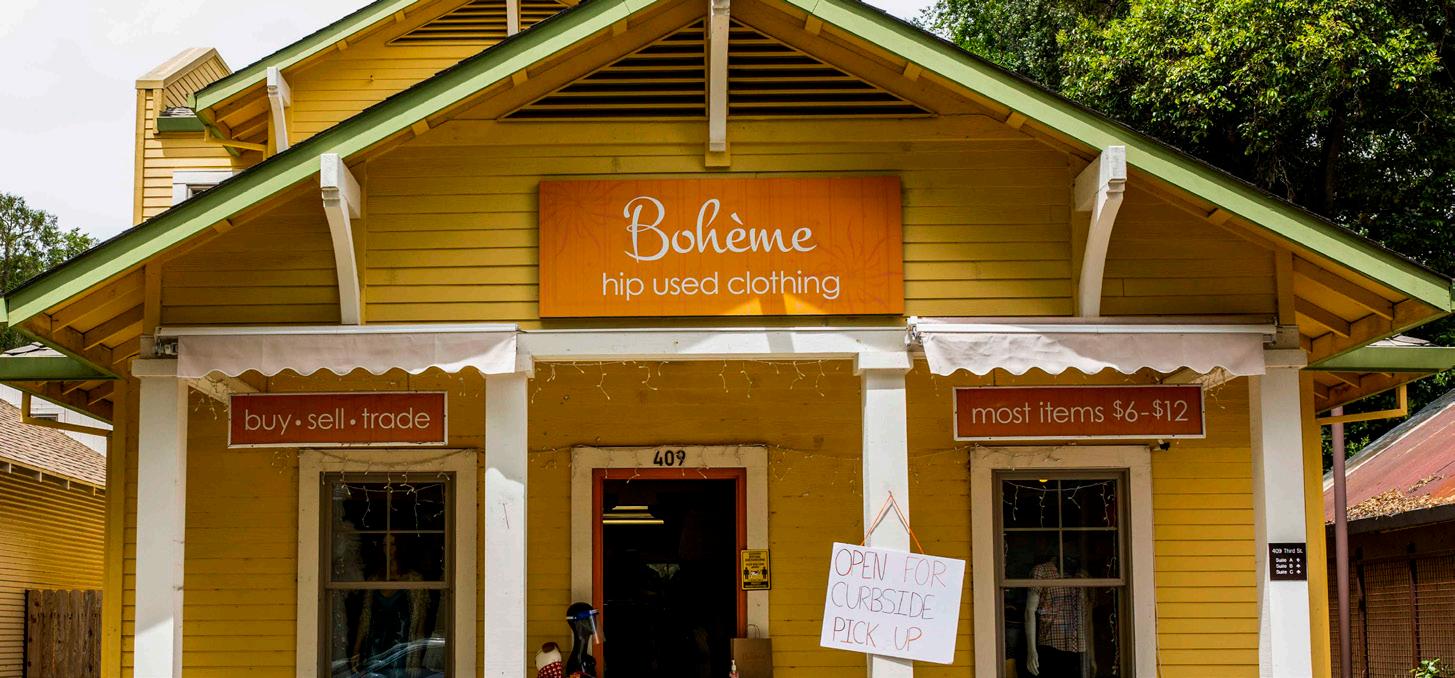
they’ll actually enjoy when all you can do is send them pictures,” Salbacka said. “We can’t watch people try things on and see how excited they get when they’re putting the clothing on and they look great and they found something new. I really just miss being able to see people happy about their clothing, it’s very distant right now.” Ivashchenko said she primarily misses the people who contributed to the store’s regular activity. “We do have a lot of regular customers, and just like, that whole aspect of seeing familiar faces and just seeing people happy, leaving the store happy — because I love helping dress up people, it’s just my favorite thing to do,” Ivashchenko said. “Just human interaction, that’s my first most important thing I miss.”
Salbacka believes that what the store offers has a different significance than everyday essential items simply picked up as a chore.
“Clothing is something that you need, but it’s also something you can choose and feel a little bit more leisurely about,” she said. “I definitely feel like it’s very important to [self-interpret] and things like that.”
At Bohème, self-interpretation is not limited. Their Instagram showcases some of their one-ofa-kind items, such as their floaty Hawaiian shirts and atypical hats. More can be found on their site.
“I would say 80% of my customers are students,” Ivashchenko said. “My store is gearing toward the students. I try to have a variety of clothes and different things, but I depend heavily on students. So if they could reach out in any way [...] — if they let me know what they are looking for — I ship items, I deliver if they’re not too far away in this area, just stay in touch, even if it’s a small comment on Instagram. I appreciate it.”
With no current store activity due to it not
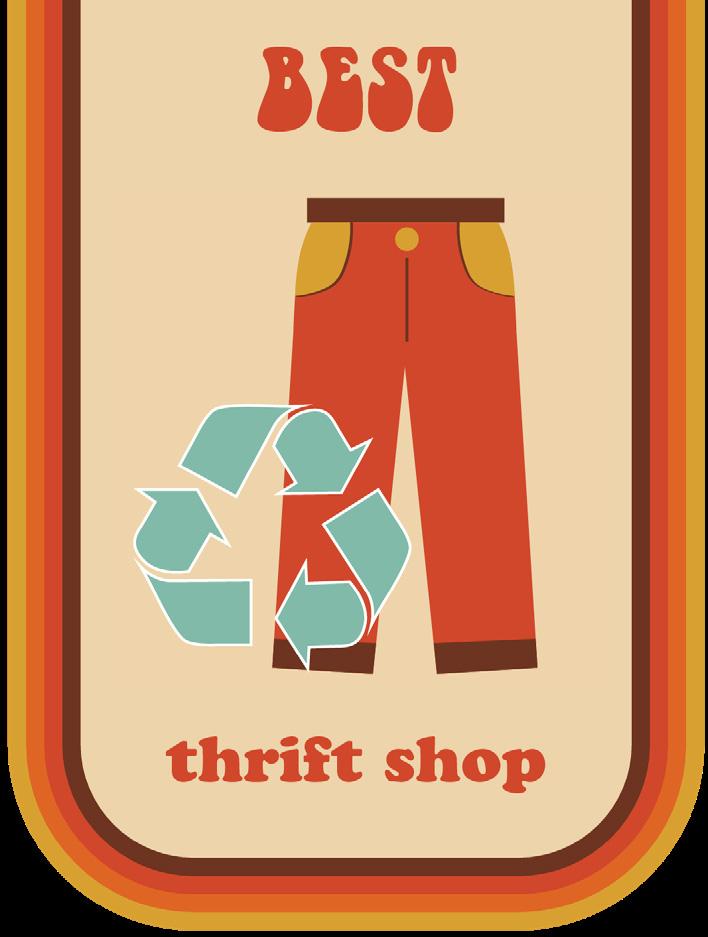
BY ATHENA AGHIGHI features@theaggie.org
Lake Tahoe, the most versatile getaway destination, won the title of Best Getaway from Davis with a 48.6% majority, beating out runner-up San Francisco. Known for its clear water and mountainous terrain, this two-million-year-old lake harbors some of the most beautiful shorelines. In addition, its contrasting winter and summer seasons make it a desirable vacation spot for both skiers and beach-goers. About two hours away from UC Davis, it makes an easy day trip as well.
Why Lake Tahoe remains champion for the best place for a weekend excursion
BEST GETAWAY: LAKE TAHOE
“My favorite thing to do is go boating all day to cool jumping rock like Rooster’s Rock,” said Frankie Vererka, a second-year human development and science and technology studies double major. “Another really cool place is Emerald Bay. The water is an unreal color. I love being on the Emerald Bay, located on Lake Tahoe’s west shore. (Aggie Files)
being an essential business, Ivashchenko has taken to utilizing her upcycling talents in her spare time by modifying some of the clothing items in the inventory. She said cravings for hot chocolate and wine have helped drive some of her creative decisions.
“I decided to tie-dye a lot of items that sometimes come to the store and they have a little stain, or the colors have washed out, so I call it self-therapy quarantine tie-dye madness,” Ivashchenko said. “I have a whole rack that’s slowly scaling up, and I’m afraid by the end of this, my store would be bursting with colors. I have this craving for hot chocolate, so I tie-dye clothes with a color called ‘hot chocolate.’ The same thing for the wine color.”

boat all day and stopping at some of the best restaurants on the lake in the middle of the day such as Gar Woods, Sunnyside and Chambers Landing.”
Nina Steinkemper, a second-year design and communication major, said winter activities in Tahoe offer a different but equally enjoyable experience.
“[I] mainly went to ski and go snow hiking with friends and family,” she said. “Hiking at the lake is so beautiful but definitely too cold to swim in the winter. Now at UC Davis, I’m on the Ski and Snowboarding team. We have a cabin all winter close to Squaw and Alpine for great skiing.”
Tahoe’s shifting landscape allows for its historic cobalt waters to be a constant appeal for UC Davis students, as the multifaceted experiences that it provides makes it an unparalleled location for nature lovers.
“I think going to Lake Tahoe during spring quarter is the best time,” said fourth-year biological sciences major Saira Singh. “It’s sunny out, but there’s still snow on the ground if you like snow activities.”
On the weekends, after the final Friday class has been let out, Tahoe remains the dreamy des
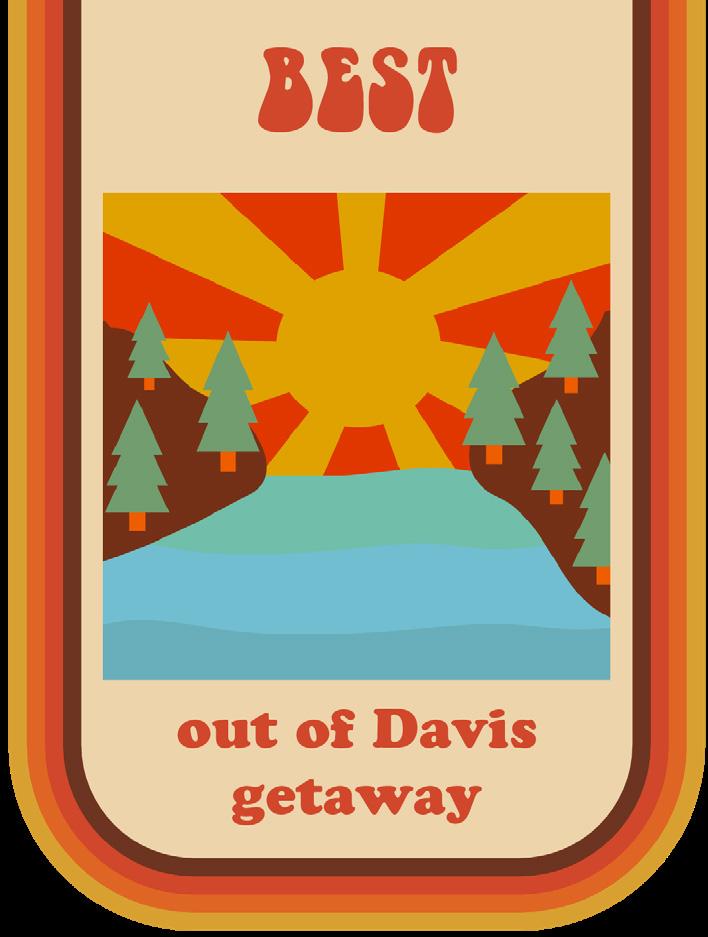
BY ALYSSA ILSLEY features@theaggie.org
Although the town of Davis may not be known for its nightlife, students have certainly found ways to entertain themselves over the years. The “Trinity” is a popular bar crawl among the 21+ crowd that has become a beloved ritual among undergraduate students.
The goal is to finish three different drinks from three different bars as fast as possible. According to DavisWiki, the average time it takes to complete all three is 90 minutes. Those ambitious enough to finish the trinity in 45 minutes, however, receive the “The Triple Crown” title. There are also variations of the Trinity, including the Red 88 Noodle Bar in Downtown Davis serves the FML. (Aggie Files)
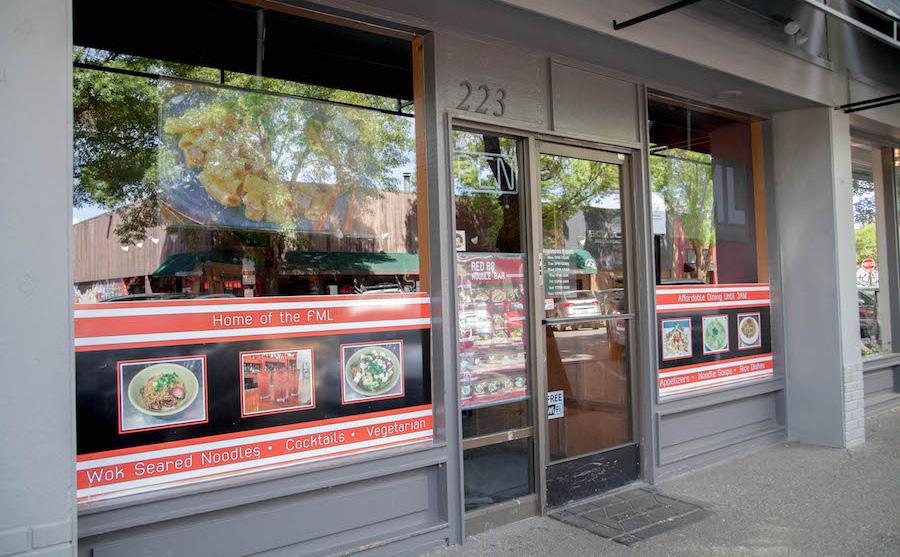
BY MARIAH CANDELARIA features@theaggie.org
From excellent customer service to their large array of products and deals, F Street Dispensary has earned its place as the Best Dispensary of Davis.
F Street Dispensary has implemented many changes in response to COVID-19
BEST DISPENSARY: F STREET DISPENSARY
Since Yolo County's shelter-in-place ordinance took effect, the dispensary has had to change its policies in order to allow community members a safe and precautionary method of transaction. Masks are required for entry and there is a limited capacity of people allowed in the store at a time. The rest of the customers F Street Dispensary is a new addition to downtown. (Photo by Quinn Spooner / Aggie)
Holy Trinity.
The drinks consist of The Devastator at Bistro 33, The FML at Red 88 Noodle Bar and the Wicky Wacky Woo at Bar Bernardo. These drinks have been determined to be some of the strongest at Davis, which is why the Trinity is such a revered rite of passage among students.
According to the Best of Davis survey taken by Davis undergraduates, the most popular of the three drinks is the FML. Typically the last drink of the Trinity, the FML is made of vodka, gin, tequila, triple sec and Bacardi 151, then mixed with Sprite and juice. At $9.50 per drink, the FML is decently affordable for its strength.
“The fruitiness of the FML masks the alcohol in it so it doesn't taste too strong,” said fourthyear psychology major Elaina Jahanfard. She first had the FML on her 21st birthday while celebrating at Red 88 Noodle Bar.
“I have really fond memories associated with this drink because all of my closest friends from different groups did it with me that night,” Jahanfard said.
For those who drink, the FML is certainly something to try once bars and restaurants open back up. Strong but still tasty and affordable, the FML is a great way to finish up your Trinity experience or try the next time you go to Red 88 Noodle Bar.

BY JOSH MADRID features@theaggie.org
Well, we’ve all got to go, and the best place to go on campus is the Mondavi Performing Arts Center, according to 35.6% of respondents. If someone is willing to go this far out of their way from campus to use a specific toilet, then that shows commitment to the business of doing business. For most of us, however, the Mondavi Center bathroom is most likely occupied during a show.
Fan favorite bathroom is clean, well-lit BEST ON-CAMPUS BATHROOM: MONDAVI PERFORMING ARTS CENTER
Upon walking into the bathroom, the lighting is soft and perfectly dimmed to create an Mondavi Center, located at the south end of campus. (Photo by Quinn Spooner / Aggie)
queue outside using tape markers to ensure social-distancing.
Due to the unprecedented loss of customer retention, however, F Street has undergone financial and employment difficulties. The dispensary is solely owned by two brothers raised in Davis, and they have had to make difficult decisions because of the pandemic’s impact. "It's been rough financially, but what I really miss is the vibrancy of the community with the students around," said Rob Reed, an F Street Dispensary owner. "I love Davis and I am excited to see everyone back."
Since the legalization of recreational marijuana in California, there has been an increase in accessibility and usage within the Davis community. In the past year alone, six new dispensaries opened in Davis — the closest store to campus is only a few blocks away.
F Street Dispensary was one of the first to pop up within the community. It opened in 2018, with others following suit. Now, the market for cannabis dispensaries has become highly competitive as businesses strive to provide the best prices and services to the Davis community.
F Street Dispensary is currently open for adjusted hours Wednesday through Sunday from 11 a.m. to 6 p.m.
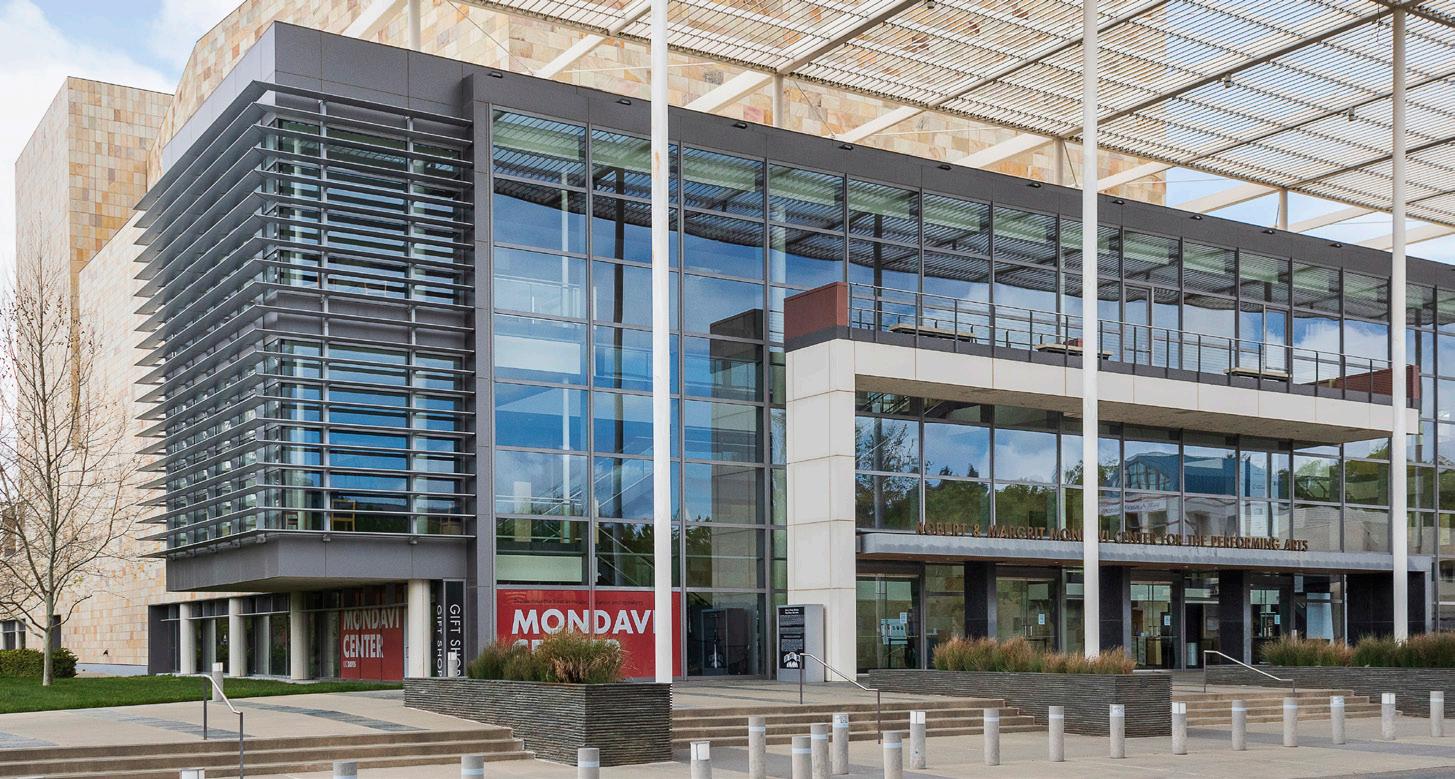
BY PRIYA REDDY features@theaggie.org
By the end of week 10 of Winter Quarter, UC Davis had been hit by a perfect storm of new situations: the machete man on campus, the COLA movement withholding grades and the quickly escalating situation with COVID-19 caught many in the UC Davis community completely by surprise.
Each day seemed to bring a new event into the lives of those on campus, and so students regularly turned to the Facebook page “UC Davis Memes for Egghead Teens” to express the mix of emotions they were feeling. The student body voted for “The Office: Only Gary May can Save us now” as the best meme of the year.
Winner: The Office, Only Gary May can save us now BEST MEME: “THE OFFICE: ONLY GARY MAY CAN SAVE US NOW”
The meme features a scene from the popular mockumentary-sitcom “The Office,” in which characters Michael Scott, Andy Bernard, Dwight Schrute and Pam Beesly are in a hang-gun standoff with one another. An Office-themed meme from the Facebook meme page. (Courtesy photo of “UC Davis Memes for Egghead Teens”)
experience unlike the one felt in the campus bathrooms built in the 1950s when people were half our size and thought fluorescent lighting was inviting. Did I mention the large gap in the stalls that make the accidental eye gaze possible?
Mazze Whiteley, a second-year transfer and psychology major, expressed why he thinks the Mondavi Center bathroom is the fan favorite.
“It’s likely a favorite because they keep it very clean, it is newly designed and has the feel of a higher end bathroom suite,” Whiteley said.
The bathroom in the Mondavi Center is clearly more clean and spacious than others on campus, and it looks like the bathroom on the first floor of an art museum (definitely mirror selfie worthy). And cleanliness and space is an important factor for students — the brand new California Hall bathroom took 33.9% of the votes.
The bathroom does make good use of the announcement system, which can make students feel like they’re not on a college campus but instead possibly a department store. Whiteley acknowledged that people may need the announcements during intermissions to let guests know when it’s time to return to their seats.
Whichever throne you tweet from in the middle of the day, remember to wash your hands when you’re done.
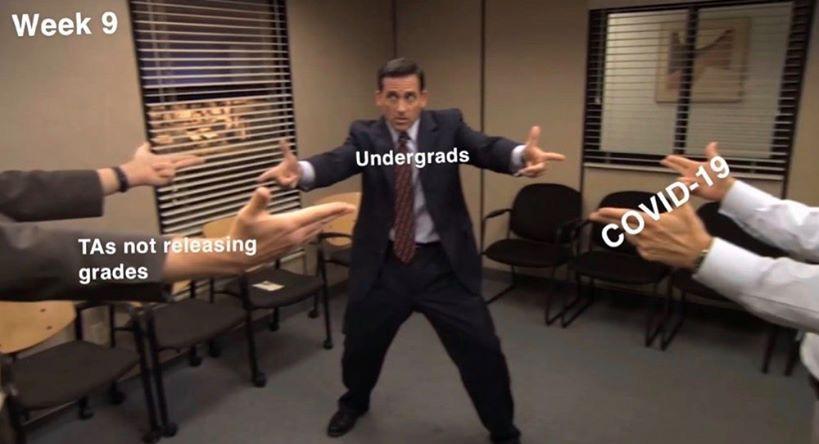
The meme’s creator, fourth-year economics major Joshua Melton, placed a label on each character, having them represent the “machete man,” “TAs not releasing grades,” “COVID-19” and “undergrads.” Watching over this is character Jim Halpert, representing “Gary May.”
“So I was watching The Office, and this episode was on with the Mexican standoff, and I thought that was sort of applicable to what was going on on campus right now,” Melton said. “I know there were the protests that were going on about the COLA [cost of living adjustment] that the TAs were not getting across all the UC campuses, and then there were rumors that COVID-19 was was getting closer to campus and then, just to top it all off, the next week we had the machete man on campus. Then a lot of people were being pretty critical of the chancellor for not doing much on any of those fronts.”
With 1,200 reactions and over 100 comments, the meme seemed to resonate with members of the Facebook page. UC Davis class of 2019 Alumnus Michelle Melton said she thinks people were able to connect with the meme because it captured the feeling that students had when faced with all of the events of the year.
“So much happened within a year — a pandemic, the machete guy,” she said. “I think that people laugh at that, people find humor during trauma [and] during stress.”

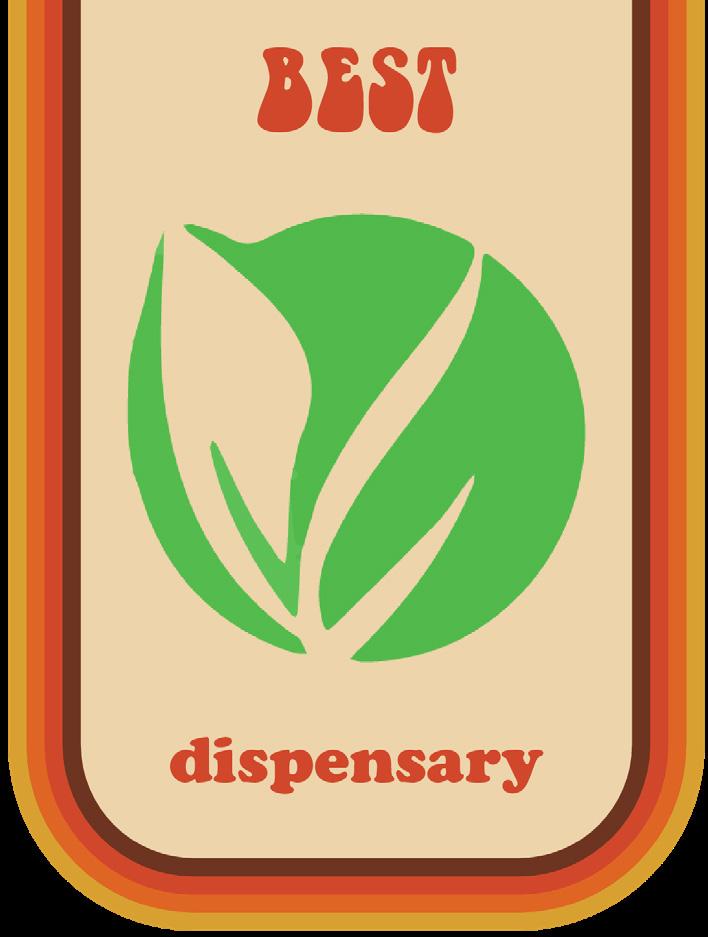
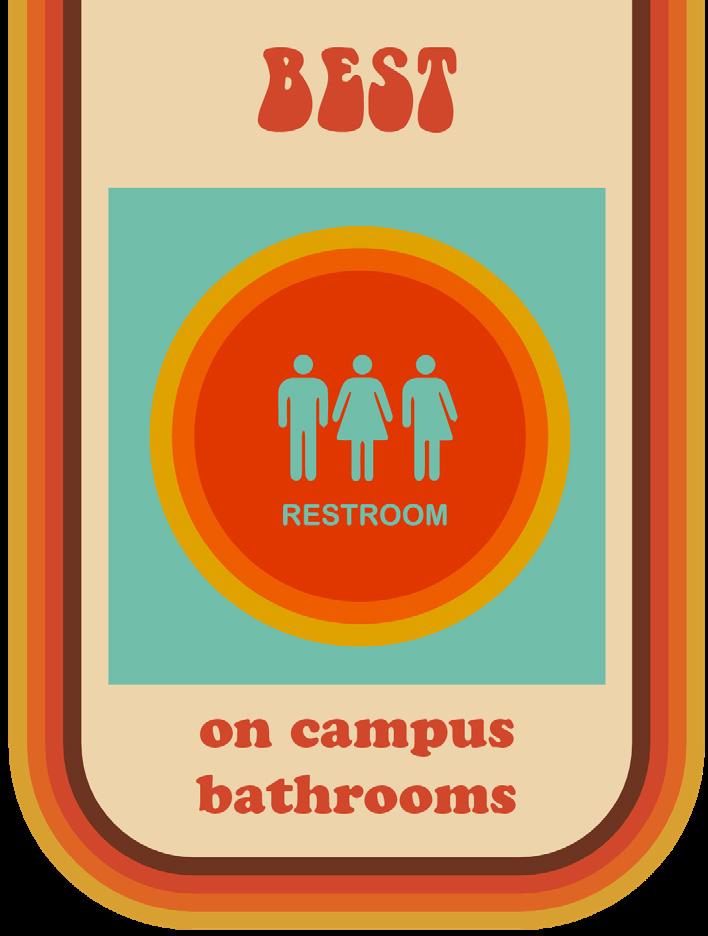
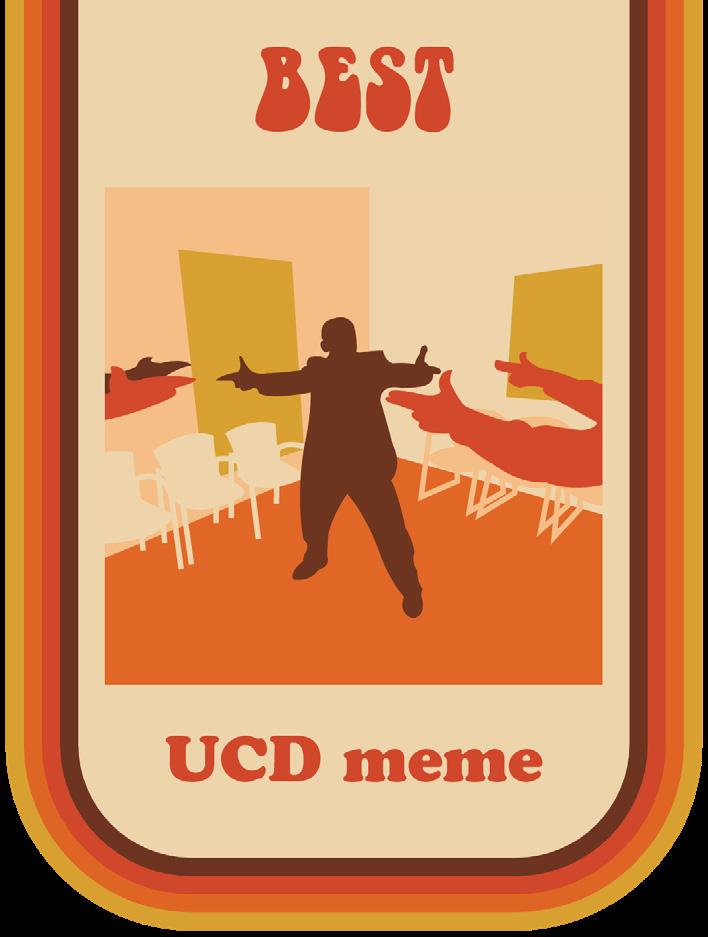

BY ANDREW WILLIAMS features@theaggie.org
It’s Thursday night and yet another three hours of your life have been sacrificed to the 24- hour room. Lost in thought, you’ve come to the conclusion that the only thing more boring than that Chem 2B textbook you’ve been glazing over is your love life. If you’re in need of a remedy to this dire situation, the Davisites have spoken, and with 43% of the vote, the bars are the top spot to meet singles and spice up your social life — beating out dating apps like Tinder and Hinge, which secured 35.4% of the vote.
Tom Robey, a fourth-year neurobiology, physiology and biology major, touted Mojito People attend "Mojito Night" on Thursdays at Bistro 33 in Davis. (Aggie Files)
Night at Bistro 33 with its open layout and laid back atmosphere as his favorite spot to spark a friendship.
“I've met a couple of people who I'm still friends with from Mojito and from bars in general,” Robey said. “There have been people who I’ve actually gotten really close to and our first conversation was over a pitcher.”
For a more low-key date night, Robey suggested checking out DeVere’s Whiskey Wednesdays, which offers intimate low lighting and halfpriced whiskey drinks.
“If you wanted to take somebody there on a date or meet somebody new, I think that's a good place to sit down and talk over whiskey drinks,” Robey said.
Brooke Kaplan, a fourth-year human development major, noted that the presence of a little bit of liquid courage goes a long way in getting people to loosen up and initiate novel conversations.
“I definitely have been approached by guys I've never met at the bars or just people In general,” Kaplan said. “The thing about the bars is everyone is drinking and when you're drinking, you become a lot friendlier. You're definitely more likely to meet people that you don't know
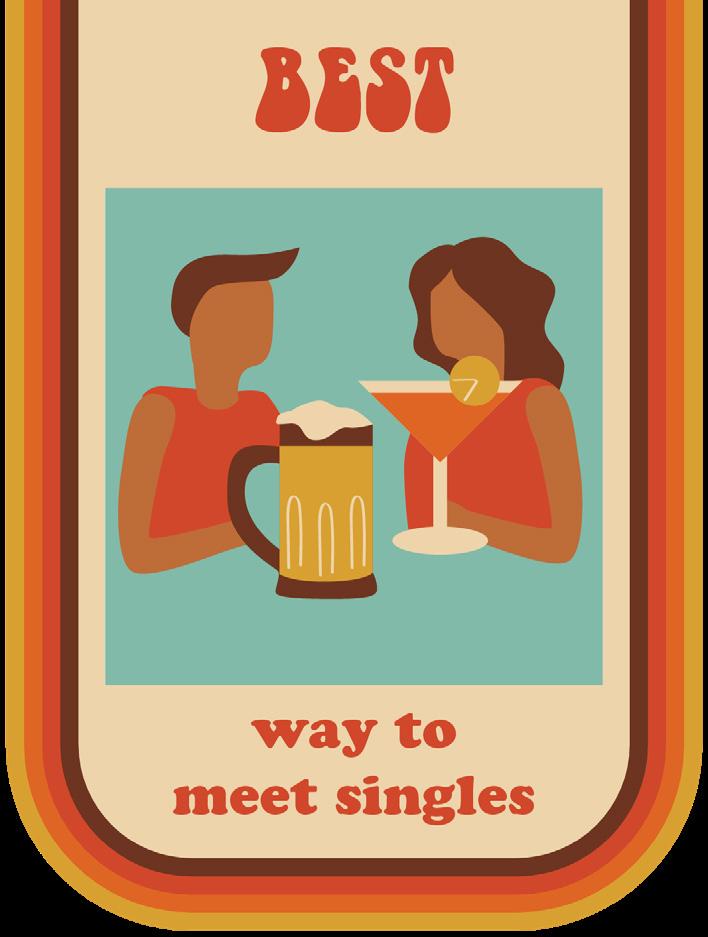
BY SABRINA HABCHI features@theaggie.org People playing IM innertube water polo. (Aggie Files)
Intramural innertube water polo is a sport that takes the physical effort out of water polo and keeps all the fun, as players adhere to the same rules of a regular water polo game but do so while in their own innertubes. The sport was created at UC Davis and has since spread to other universities. Many organizations on campus and different groups of students form teams to play IM innertube water polo each spring. One organization includes the Welcome Center team, largely comprised of tour guides.
Molly Doyle, a third-year design major and a
Fun competition without the usual accompanying physical difficulty
BEST IM SPORT: INNERTUBE WATER POLO
current tour guide, said she joined the Welcome Center team for innertube water polo last spring.
“I was pretty nervous, because I had never been with this group of people in an athletic setting,” she said.
Despite her initial nerves and lack of practices or meeting before the first game, Doyle said the experience ended up being very positive.
“It was super cool, because we all had no experience; it was kind of just like a free-for-all, so it was really fun to get into it,” Doyle said. “It gets pretty competitive, I think Victor and I and Cameron — another tour guide — all really got involved and so we got competitive with it.”
Victor Reyes, a fourth-year biological sciences major and the tour guide who suggested Doyle join the Welcome Center team, described having a lot of fun playing after feeling a “little scared” when first jumping into the pool.
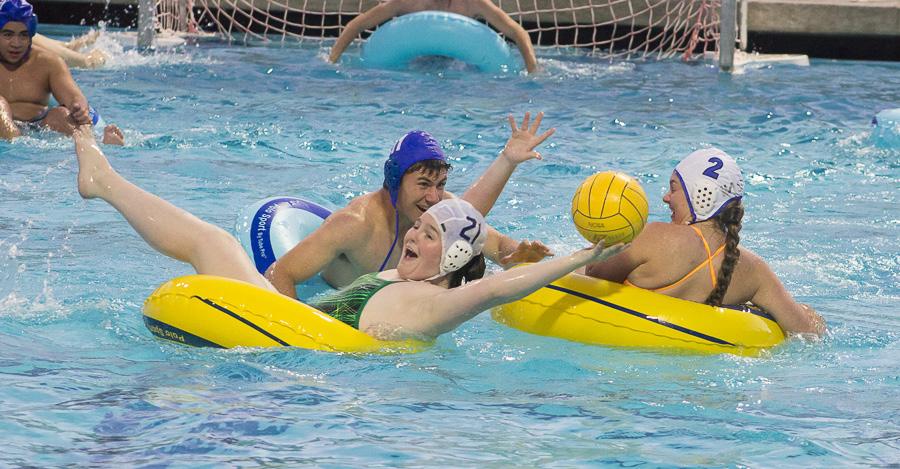
“I had no idea what was going on and as I looked around neither did anyone else,” Reyes said via email. “It was a magical experience and a great sport that students, like myself, can use as a good distraction from school.”
Like Doyle, Reyes has been a player on the Welcome Center team since his second year — organizing the tour guide team himself. He remembered the successes the team had in the last year.
“The first year I did tube polo, my team and I lost every game except for the ones that we had to forfeit,” Reyes said via email. “However, last season we won most games except for a few against the actual water polo teams.”
Doyle recounted being on a team with her coworkers as “the best part” of playing the IM sport.
“We interact in a pretty casual setting being tour guides, anyway, but when you get to hang out with them after hours, that was when I got to form a lot of friendships with them outside of work,” Doyle said. “It’s just a cool experience to play with other college students who you wouldn’t normally see and then having that kind of comfort of being with your co-workers as well.”
Reyes echoed this sentiment and said the team was a great way to get to know some of his co-workers that he would have otherwise not spent time with.
when there's some alcohol involved.”
So once it’s safe to gather in groups again, grab your friends, stop swiping and head downtown to make a few genuine connections.
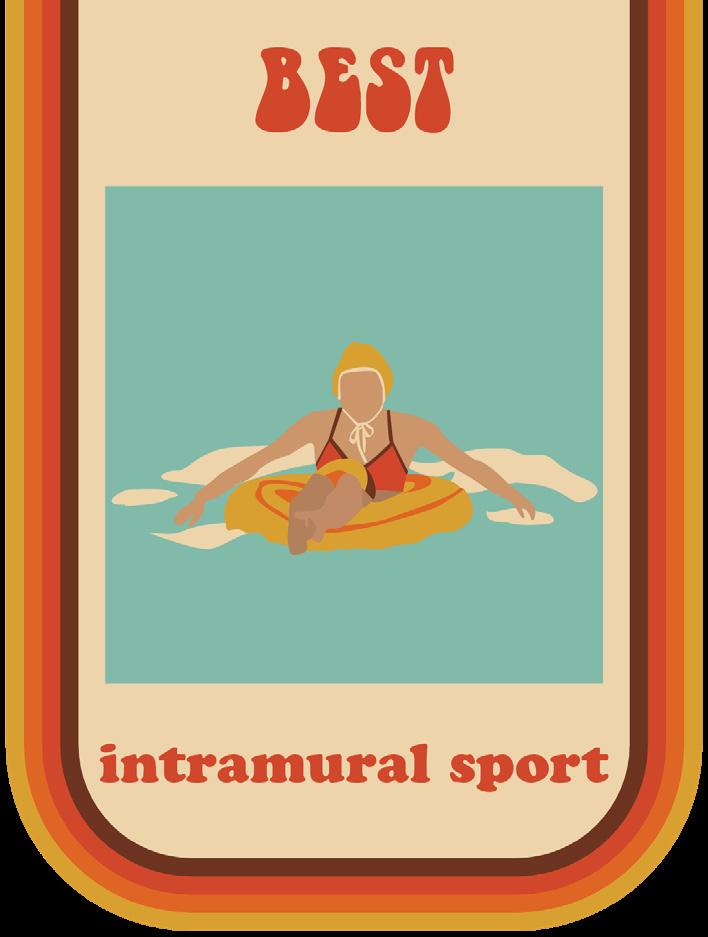
BY OMAR NAVARRO features@theaggie.org
Whether it’s a chilly afternoon in late Fall Quarter or a cold night at any point throughout Winter Quarter, heading to The Pavilion and watching the Aggies play basketball is a staple for many students at UC Davis.
Students say basketball games allow them to feel like they are part of a community
BEST UC DAVIS SPORT TO WATCH: BASKETBALL
Taking home 40% of the vote, basketball at UC Davis is one of the campus’ must-see attractions, largely due to the success that both the women’s and men’s programs have had in recent years. Both teams provide fans with thrilling finishes year in and year out, especially in the Big UC Davis guard Katie Toole (13,middle) goes up for a layup during the match against the University of Hawaii on Saturday, Jan 11. (Photo by Justin Han / Aggie)
“For example, my really good friend Molly, I would have never gotten to know her as well as I do now if it were not for tube polo,” Reyes said via email.
Both Doyle and Reyes highly recommended other organizations on campus form teams to play if the sport comes back next spring provided that the threat from COVID-19 has been mitigated.
“It’s a great stress relief and during the spring,” Reyes said via email. “Why not try something that you can really only do in college?”
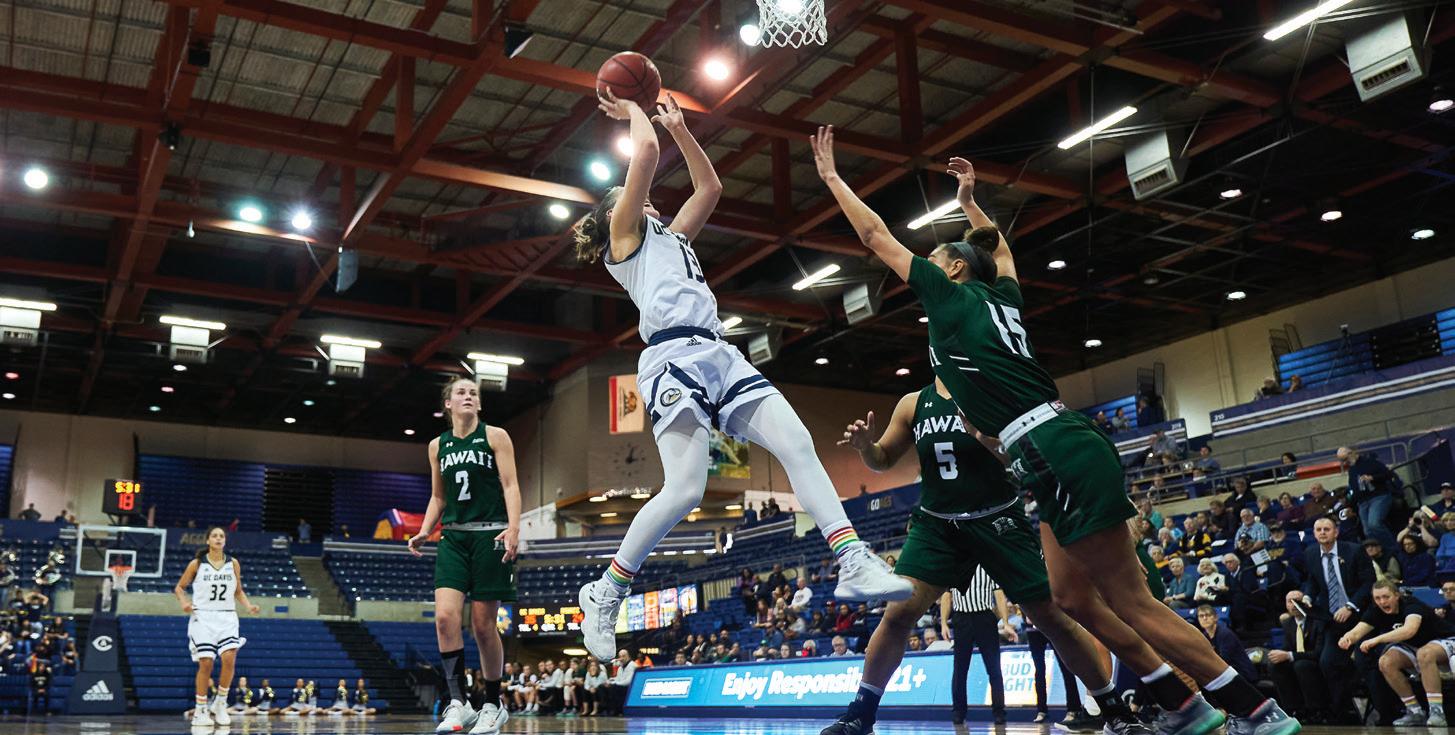
Whether it’s to get your sweat on, to calm down after a stressful day or just to feel a sense of community, many Davis students turn to practicing yoga at Barefoot Yoga Studio, located downtown at 1015 Olive Dr. The studio offers an array of classes including vinyasa and gentle flows, as well as basic yoga classes and even kids yoga.
The studio, founded by Robert Boswell in 2005, is a staple of the Davis community, with 47.4% of Best of Davis voters choosing Barefoot as their favorite studio. And the appreciation goes both ways: Boswell said the atmosphere that college students bring to Davis and to Barefoot makes the community what it is. “Yoga perpetuates the idea that you are always a student, and I think having college students around adds to the energy [of yoga] that comes out in that age group, which is open and receptive,” he said.
Studio offering virtual yoga classes over Zoom
BEST YOGA STUDIO: BAREFOOT YOGA STUDIO
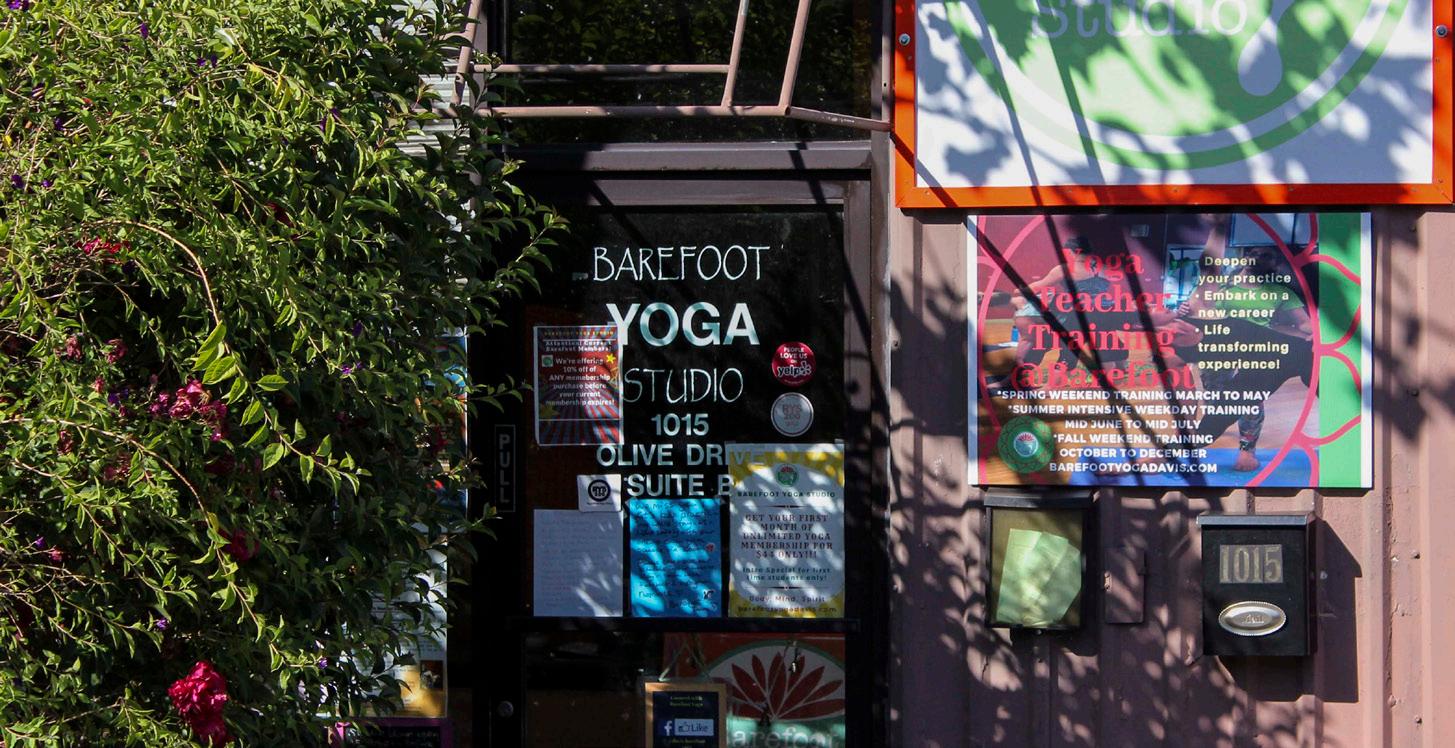
BY KATIE DEBENEDETTI features@theaggie.org
The studio aims to make the practice of yoga accessible and to share the message that Boswell Barefoot Yoga Studio on Olive Drive. (Photo by Quinn Spooner / Aggie)
West Conference, where the majority of the contests are neck and neck.
For second-year math major Sharon Sandoval, going to basketball games allows her to feel like she’s a part of the school community and to experience the thrill of the sport in a more compact environment.
“I enjoy the atmosphere,” Sandoval said. “Being inside is a plus and I feel like, since it is, everyone in the crowd is closer, building a stronger front when supporting the team.”
Fourth-year history major Robert Henderson echoes the claim, explaining what separates a UC Davis basketball game from other sporting events.
“The atmosphere is insanely fun,” Henderson said. “If you get there early enough and grab a seat in the first row, you’re right on top of the action and you can feel the energy.”
Being able to sit right near the action adds another unique element that is hard to replicate for fans of other sports. Both Sandoval and Henderson credit the up-beat style of play that each team utilizes at these games, making every moment of the games exciting.
With both teams constantly right in the mix of the conference championship picture, basket
has found through yoga with Davis students, as well as the whole Davis community. Boswell, who found yoga after an injury that ended his running career, said the studio is brought to life by the diversity of Davis.
“The discipline of yoga brings a sense of happiness and freedom, which we try to encourage,” Boswell said. “We want a heart-felt, community based studio, and that’s what I like about college town studios — it brings diversity”
Nisha Marwaha, a recent UC Davis graduate who interned at Barefoot Yoga during her time at the university, said the community is what makes Barefoot such a special studio to practice at.
“It’s just kind of like a family there,” Marwaha said. “The community and the teachers [...] were just a kind of family that I had in Davis when you’re in college and your family is far away. Just knowing that I always had their support and they watched me grow [...] was just a wonderful opportunity.”
Shannon Mayhew, another Davis graduate and loyal Barefoot yogi who also previously interned at the studio, agreed that the people and the atmosphere at the studio make it a special place.
“It’s kind of in a funky location, right across the street from In-n-Out, and it's super hidden, but once you enter it’s kind of like a secret garden,” Mayhew said. “There’s plants and tapestries and posters and it smells amazing and you walk in and see all these smiling faces. In the commuball has become one of the most popular sports at UC Davis. The excellent coaching staff in place for both sides will make it take a lot to stop these programs in the near future.
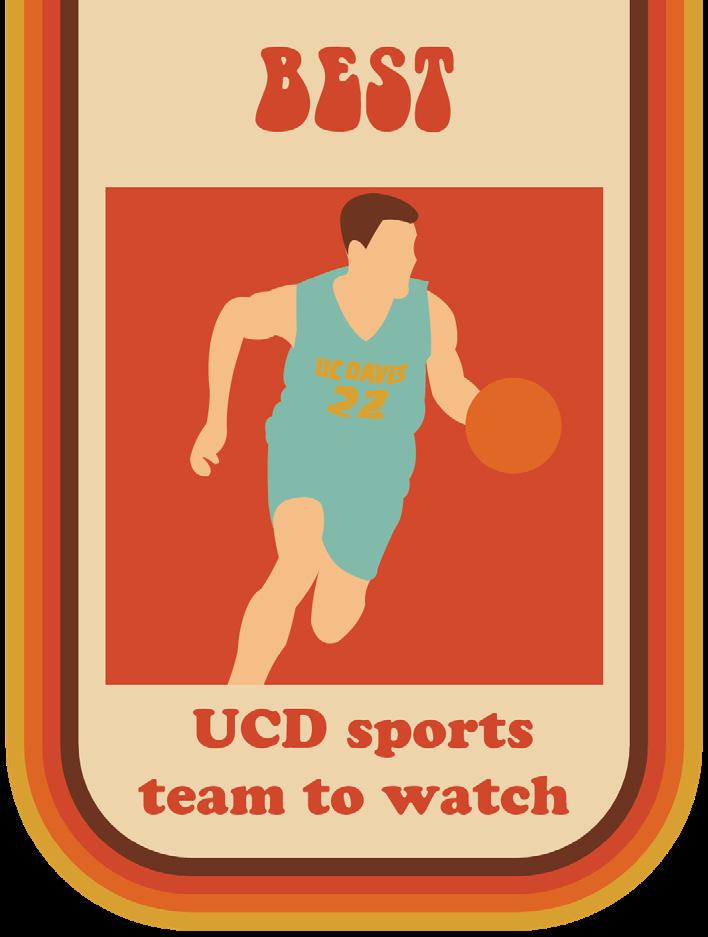
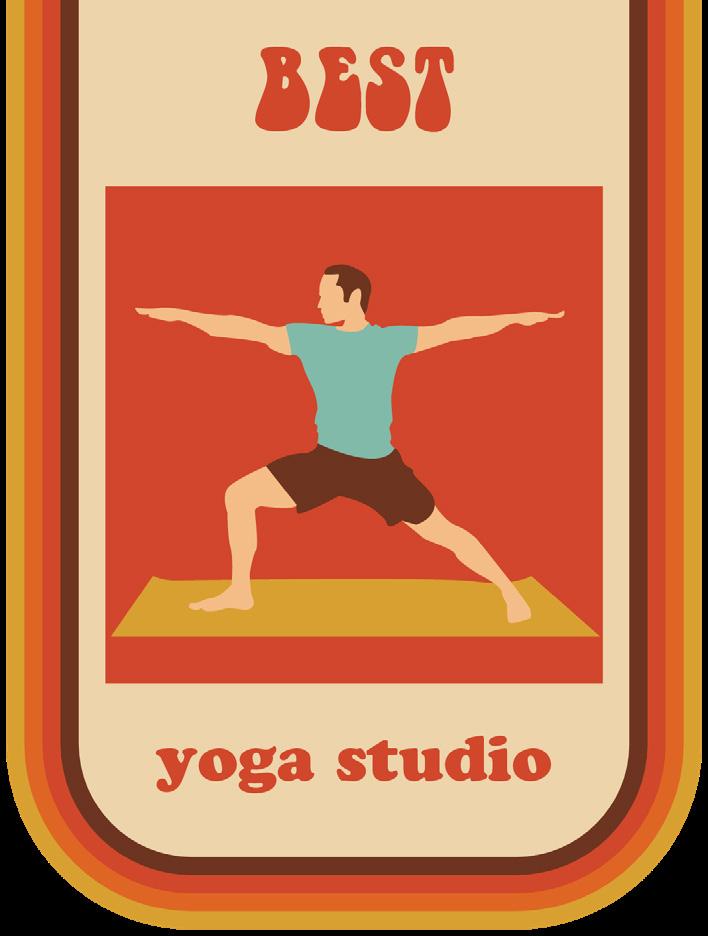
BY ITZELTH GAMBOA arts@theaggie.org
TV Show: “Dickinson”
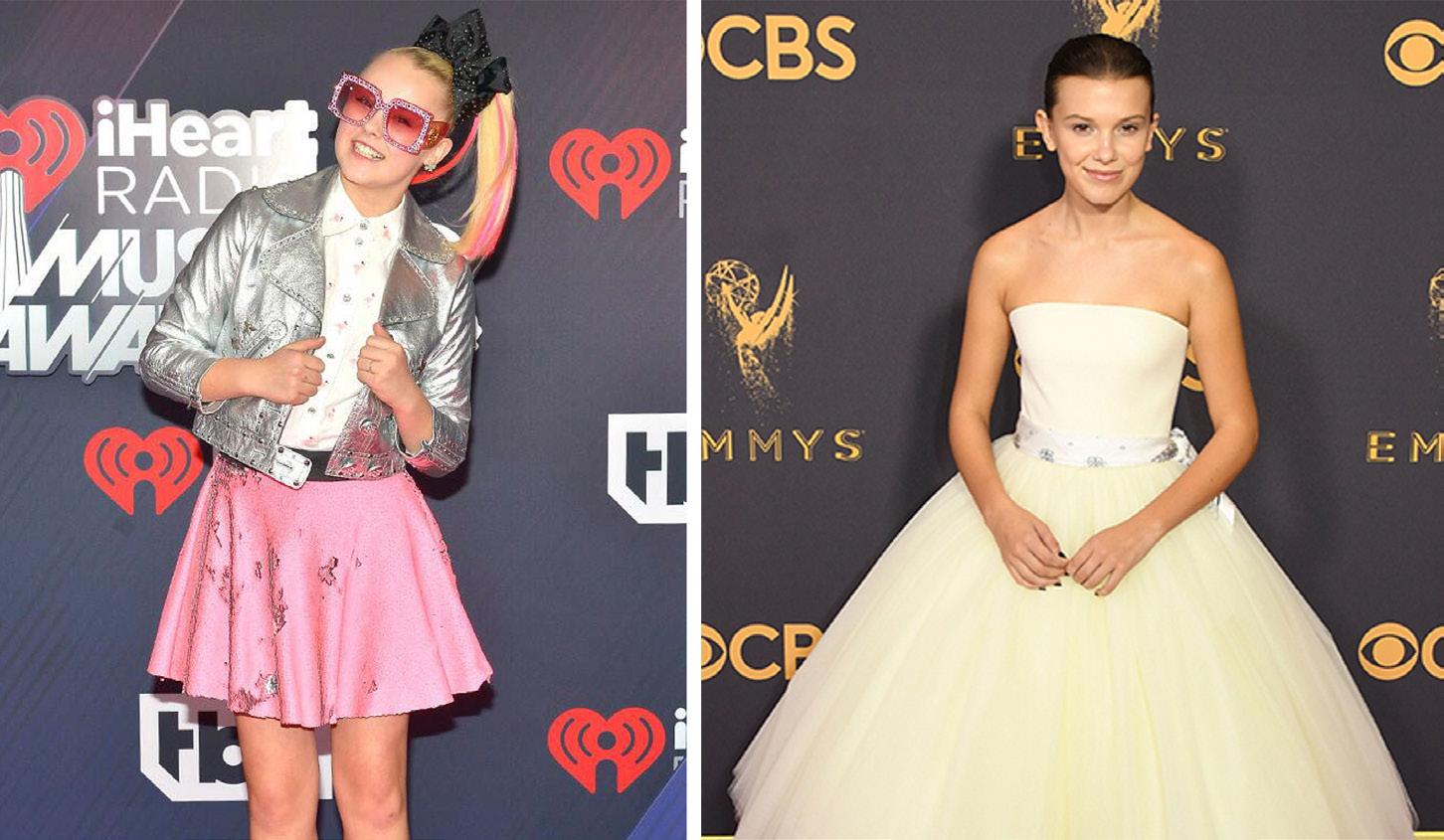
Child actress Millie Bobby Brown sparked controversy at the 26th annual Screen Actors Guild Awards over what she was wearing. Only 15 at the time, Brown was dressed in a low-cut Louis Vuitton coat-dress outfit. While some took to Twitter to criticize her team for dressing her in such a mature manner, others have spewed hate and insults at Brown, judging her character. Some defended the outfit choice and claimed that the 15-year-old should own her sexuality.
“Did people criticize her SAG Awards look for her sake, or because it made them uncomfortable?” questioned an article in Popdust. “In the same way that it is absolutely inappropriate to sexualize Brown, is it not also inappropriate and unfair to forcefully ignore her sexuality completely?
Brown’s team made a deliberate decision to dress her in such an adult way for a publicized awards show, and the response it elicited from the public reveals a prominent issue deeply entrenched in the entertainment industry: Young female stars are hyper-sexualized by the business that they are in, then either celebrated or criticized for that same sexualization by the public.
This is no new phenomenon. One of Shirley Temple’s first roles in 1932 was as an exotic dancer in a bar for soldiers in “War Babies.” She was three years old at the time. Throughout her childhood, she was placed in roles that were oddly mature for a young actress. An article in The Guardian analyzes Hollywood’s “Lolita complex” and the ways in which those in charge of Temple’s career exploited the sexualization of her childhood innocence. “[They figured] out just how to preserve the veneer of innocence while teasing the men who proved her greatest admirers both on and off the screen,” wrote Molly Haskel. “Often orphaned, she finds herself the darling of bachelors, widowers, lonely uncles, in ‘love’ stories that feature non-childlike caresses on both sides.”
Jojo Siwa (left) and Millie Bobby Brown (right). (Photo Courtesy of Getty Images)
BY ALYSSA ILSLEY arts@theaggie.org
The 1994 film “Léon: The Professional” uses a similar trope explained in the article. Natalie Portman, only 12 at the time, played a character who developed an unusual relationship with an older man through a presumed case of Stockholm Syndrome. Despite Portman’s acting merits, the public’s reaction to the film would cause overt sexualisation and harassment that would follow her throughout her career. Portman is open about the horrifying objectification she experienced as a child. Her first fan mail ended up being a rape fantasy story written by a grown man. Later, a local radio station would start a countdown to her 18th birthday.
At the 2018 Women’s March, Portman spoke about the effects of constantly being seen as a sexual object for grown men at such a young age.
“At 13 years old, the message from our culture was clear to me,” she said in her speech. “I felt the need to cover my body and to inhibit my expression and work in order to send my own message to the world: That I’m someone worthy of safety and respect. The response to my expression from small comments about my body to more threatening deliberate statements serve to control my behavior through an environment of sexual terrorism.”
This sexual terrorism continues to permeate the industry. Brown has received the most criticism out of all her male co-stars on “Stranger Things.” Her publicity team and those around her push a mature narrative on the young actress in order to enhance her career, while the media seems to be torn between objectifying Brown and criticizing her for allowing herself to be objectified in the first place.
DOUBLESTANDARD on 17
Dickinson is a historical comedy-drama series based on the life of Emily Dickinson. Staring Hailee Steinfeld as Dickinson, she takes on the character that lived unapologetically through her poems. The series touches on the possibility of what Dickinson’s life could have been like as she faced gender and family impositions. With the use of her poems as the main narrative, the show portrays a clever take on her life. “Dickinson” has a new spin on the historical narrative and the language we use now. It brings a fresh perspective for Dickinson fans and the everyday viewer. I love historical fiction, but my favorite ones are those that make the story relatable to what we live in now. “Dickinson” provides everything I wanted in this kind of genre and I was surprised I loved it as much as I did.
Movie: “The Half Of It” dir. Alice Wu
Wallflower Ellie Chu spends her high school days writing papers for her peers in exchange for some extra cash. When a dim jock with a heart of gold, Paul Munsky, offers Ellie $50 to write a love letter, she initially refuses. But with enough persistence, she agrees, and the two set out to make Aster Flores fall in love with Paul. However, the pair quickly become aware that they need more than just love letters. Cue the montage of lessons on writing, poetry, conversation and love. I hate using the word underrated, but nothing describes this movie more. It’s not getting the praise it deserves. It’s rare to find a mixed-race lesbian couple on screen, it’s rare to see their love bloom and it’s even more rare to not sexualize every part of it. I also just love the dumb-jock-with-a-kind-heart trope. But I think the best part was that the movie branded as a romance wasn’t solely about a romance. The movie was perfect, and I fell in love with every character they gave me. It made my heart melt in a small time span, and I only wish I could erase my memory so I could watch it again for the first time.
Book: “Go Ask Alice” by Beatrice Sparks
I always appreciate a book in diary form. The 1971 fiction focuses on a teenage girl’s life as she turns to drugs and runs away from home. The language makes you feel like you’re walking in unannounced, seeing things you shouldn’t have. It is also a widely banned book in the U.S. and as we all know, we need to read banned books.
It must be said. GLEE CAST VERSION VS. ORIGINAL SONG
Music: Dove Cameron
Dove Cameron is not only an Emmy Award-winning actress but also a Broadway singer. Her new singles such as “Remember Me,” featuring rapper BIA, dives into her potential as an adult, leaving behind the Disney scene. She’s on her way to finding her own voice through music and an exploration of stories she couldn’t delve into as a Disney actress. With her recent upsurge of singles, the 24-year-old actress continues to surprise me with her new music, giving me something I never knew I needed.
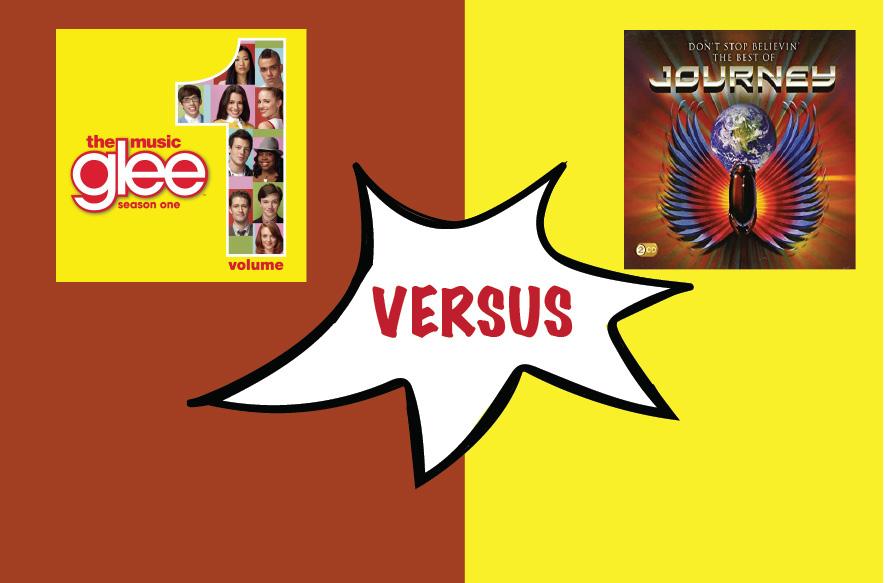
TESSA KOGA / AGGIE
RABIDA / AGGIE
BY LIVVY MULLEN arts@theaggie.org
Disclaimer: Before you disagree or get upset, I have, like, really incredible taste in music. Also, I took a class called “Intro To World Music” so, yeah… I know what I’m talking about. Plus my Glee playlist has 12 followers.
“Forget You (Glee Cast Version)” vs. “Forget You” by CeeLo Green
Am I saying Gwyneth Paltrow is a better musical artist than CeeLo Green? No. Does she absolutely body “Forget You”? Yes! We learn that Paltrow is a triple threat (acting, singing, dancing) seconds into her performance as Holly Holiday, the Spanish teacher who liberates the Glee Club from the chokehold of Mr. Schue. The original “Forget You” is a beloved classic, but it does not have Santana Lopez belting over the last few notes — which, honestly, is enough to make any song better than the original. Also, Paltrow won an Emmy for her performance so… I’m sorry, but maybe when CeeLo gets his Emmy, we can talk. It is very subtle, but if you really understand music and the lyrics, you undertand that Paltrow is singing from a feminist standpoint by switching to he/him pronouns (queen behavior).
Winner: Glee Cast
“Don’t Rain On My Parade (Glee Cast Version)” vs “Don’t Rain On My Parade” performed by Barbra Streisand
I’m sorry, but Ms. Streisand was just not hitting those notes like Rachel Berry! The original is retro, I suppose, but it’s honestly kind of hard to listen to Streisand’s version because the Glee Cast version is burned into my brain. It is a heightened, emotional experience. The stakes are high (sectionals), the outfits are to die for (big red bow on the back) and Rachel is giving it her all. When she sings “I’ll march my band out” and the rest of the Glee club walks out? Yeah, that’s history. They’re gonna teach that in schools. In the end, both #Jewishgirlsslay.
Winner: I mean, twist my arm...Glee Cast
Any Cover Sung by Will Schuester vs. The Original Song
By now, everyone knows Will Schuester is a freak who should not be allowed near children, but I don’t think we, as a generation, bully him enough for his musical flaws. He has the unique ability to make every song bad and every scene boring. His performances instill debilitating physical discomfort in viewers forced to watch him strain his voice to a Journey song while writhing on the floor. His disgusting rendition of “Gold Digger” should have been banned from national television and made me stop liking music for a while. Will Schuester, trust you will be dealt with.
Winner: Nobody. We all lose when Will Schuester is allowed to perform. #lockhimup
“The Rocky Horror Glee Show” vs “The Rocky Horror Picture Show” (Soundtrack)
The first time I watched “The Rocky Horror Picture Show” was jarring. I expected the fun songs I knew from Glee, but instead I was met with terrible voices and an incomprehensible plot. Now, I know the girlies who went to the midnight showings every Saturday are going to be mad, but hats off to Glee for taking only the good parts, because that movie is a mess. That said, every song on the Glee album is an incredible serve. “Damn it, Janet” is the best song Finn has ever performed; we get to hear Kurt’s weird little voice singing nonsense on “Science Fiction Double Feature” and “Time Warp” creates instant euphoria. It really is musically better in every possible way.
Winner: Glee Cast
“Girls Just Wanna Have Fun (Glee Cast Version)” vs “Girls Just Wanna Have Fun” by Cyndi Lauper
This cover is a disgusting travesty. It’s like Ryan Murphy was given a direct order to completely butcher Lauper’s version beyond salvation. The original is something fun for the girls to get ready and party to. The Glee version is Finn (a man) singing a slowed, acoustic ballad rendition to Santana after outing her to the whole school. If the musical aspect weren’t enough, the presentation of homophobic beast Finn as a hero is. Quite possibly the worst Glee cover of all time. Definitely in the top five at least.
Winner: Cyndi Lauper
“Poker Face (Glee Cast Version)” vs “Poker Face” by Lady Gaga
It’s hard to compare anything to the cultural revolution that is “Poker Face.” Glee knew this and switched it up. Unlike “Girls Just Wanna Have Fun,” the rearranging of “Poker Face” makes the original almost unrecognizable but keeps the good parts. In the show, it is a mother-daughter duet, which is great because they are both amazing singers but also because it makes you really contemplate how two nonblood related women can share one bone structure. It may take six to 12 listens to enjoy, but once it clicks, whew! True musical rebirth.
Winner: Tie Honorable Mentions for the Glee Cast: Any Madonna song, “Survivor/I Will Survive,” “Bust Your Windows,” “Don’t You Want Me,” all songs performed by the Warblers, “Run Joey Run,” “Landslide,” “Thriller/Heads Will Roll,” “Edge of Glory,” “Valerie,” “I’m Still Standing” (which, way better than Elton John, but not better than the “Sing” (2016) version) and “Blame It on the Alcohol.”
Honorable Mentions for the Original Art
ists: None. Two-hundred and seven Glee songs charted on The Billboard Hot 100. Take notes.
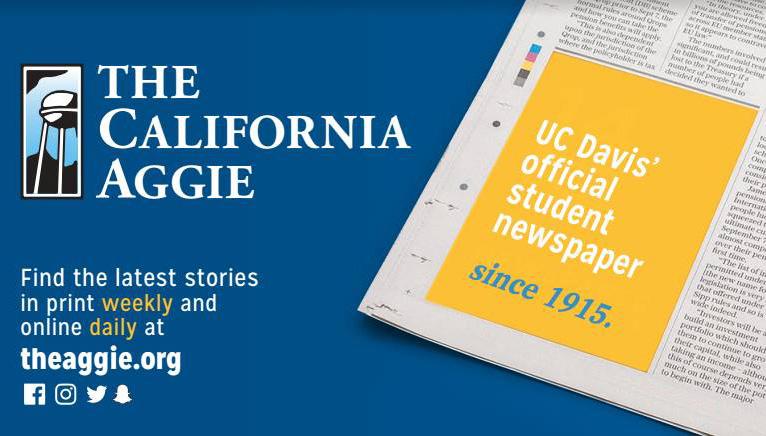
TESSA KOGA / AGGIE
BY MARGO ROSENBAUM
science@theaggie.org
Giant, tiger-striped insects have been making quite the buzz lately. Vespa mandarinia, or the Asian giant hornet, typically lives in eastern and southeastern Asia, but two individuals of the species were sighted in the U.S. for the first time.
The Washington State Department of Agriculture (WSDA) verified two reports of the Asian giant hornets near Blaine, Washington in December of 2019. One report was of a dead hornet, while the other was of one spotted flying back into the forest. Additionally, a giant hornet nest was found and destroyed in a park south of Nanaimo, British Columbia, Canada.
In Washington, neither the second hornet nor its nest were found, but researchers are fairly confident their removal efforts were successful. In April, Blaine local authorities alerted residents to the possible threat and asked them to stay vigilant, according to the WSDA.
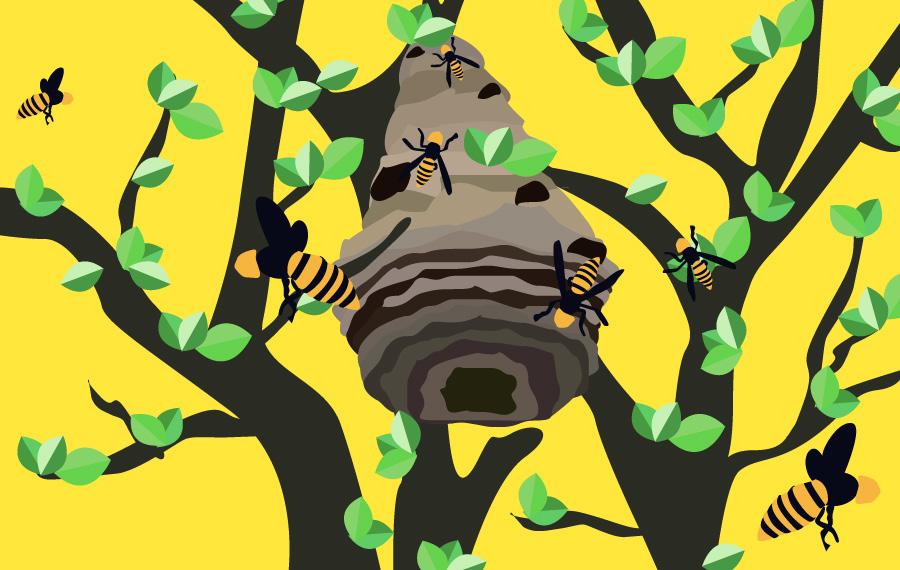
“They found a dead individual and were able to confirm that, yes, this is Vespa mandarinia,” said Eleanor Field, a doctoral candidate in entomology from Iowa State. “Then the same resident also said, ‘Hey, I saw another one and it went off into the woods.’ That means we have one confirmed dead individual and another presumed confirmed sighting.”
Although recently introduced potentially invasive species should not be downplayed, many researchers, including Lynn Kimsey, a professor of entomology and director of the Bohart Museum of Entomology, believe the media exaggerated the severity of this issue.
“[Somebody] at the Associated Press got bored with coronavirus coverage and decided to whip up frenzy on something else, but it’s absolutely ridiculous,” Kimsey said. “This happened almost six months ago. This is old news.”
While nobody knows exactly how these hornets arrived in the west coast, most likely a mated queen was transported via shipping cargo from Asia to the U.S, Kimsey said.
One possibility is that someone brought a colony to the U.S. to eat the larvae, but that is “less likely,” Kimsey said. While this species is novel to many people in the U.S., these insects are well known in Asian cultures, and their “crunchy” and “very flavorful” larvae are considered a delicacy, Kimsey said. This species has also been well studied by scientists in Asia, especially in Japan.
“As large and as nasty as these wasps are, they’ve been in China and Taiwan and Korea and Japan for thousands of years cohabitating with people and beekeepers there,” said Douglas Yanega, the senior museum scientist for the Entomology Research Museum at UC Riverside.
Although the term “murder hornet” has been readily adopted by news outlets, Asian giant hornets present no more of a threat to humans than other species in North America. All hornets will sting intruders multiple times with their straight stingers to defend their hives, Field said.
“There’s nothing more aggressive about this species that makes it sting multiple times, it’s just physically able to do that,” Field said. “Their venom is a little more potent than honeybee venom, but it’s not the most potent venom. It’s not even the most dangerous hornet of them all.”
Unless individuals have an allergy or receive dozens of stings, stings from these hornets rarely require medical attention, Field said. In Japan, these hornets kill up to 50 people per year, according to The New York Times.
“It’s very, very unlikely that a person here in the United States is going to come across these guys,” Field said. “These are big hornets, so you’re probably going to know that they’re there. So, the risk is pretty low for people here in the United States.”
Just because the hornets have been introduced to North America does not mean a population will be successfully established. Many barriers exist for species in new environments, such as surviving new climates and competing with native species, Kimsey said.
Since hornets are social insects, the survival of their reproducing queen is paramount to a population’s success, Field said. Queens mate in the fall, hibernate through the winter and reemerge to reinstate the population in the spring. The one hornet that escaped in Washington would not be able to survive on its own.
TESSA KOGA / AGGIE
The built environment and building design may influence disease transmission more than previously believed, according to a collaborative review recently published by researchers from UC Davis and the University of Oregon.
BY DINA GALLACHER
science@theaggie.org
Humidity, ventilation among factors that affect viral transmission within buildings ROLE OF ARCHITECTURE IN DISEASE TRANSMISSION EMPHASIZED IN RESEARCH FROM UC DAVIS, UNIVERSITY OF OREGON
The review highlights various structural elements of buildings, such as ventilation, air flow patterns and humidity levels, which may influence how easily a virus spreads between people within a building.
Among those involved in the collaborative journal review were Professor Jonathan Eisen in the Department of Medical Microbiology and Immunology, David Coil, a project scientist, and colleagues from the Biology and the Built Environment Center at the University of Oregon.
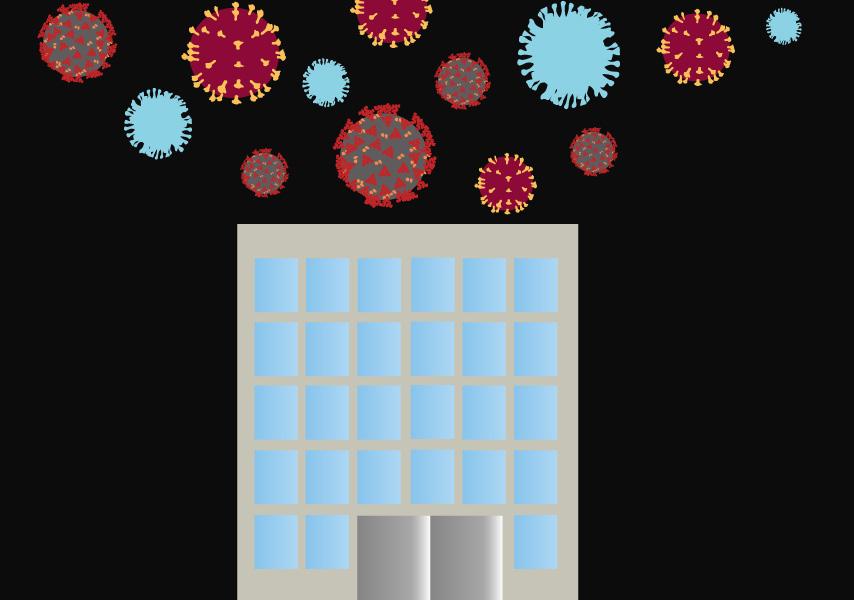
“When the pandemic occurred, we started thinking about how we could contribute to the fight against this virus,” Eisen said via email. “We have been putting in many proposals on various topics and two have recently been funded, but we do not have any major results yet [as] we just started this work.”
Due to the recent emergence of COVID-19, little research has been formally published relating viral transmission and the built environment. UC Davis researchers, however, elected to continue their study with the Biology and the Built Environment Center at the University of Oregon due to their expertise on the subject.
“There’s a ton of information cycling around about COVID-19, most of it related to clinical stuff and human transmission and things like that,” Coil said. “Our group in Oregon has worked for many years on the microbiology of the built environment.”
The focus of the review and the topic of viral transmission is highly multidisciplinary, with relevant links to various fields including architecture, engineering and microbiology.
“The review paper was just that — a review,” Eisen said. “With the other authors we went through the literature and reviewed what was known about the virus and the built environment.”
Although more research must be completed before definitive statements can be made regarding COVID-19 and the built environment, there are general guidelines that can be followed to reduce transmission likelihood within buildings, such as considering that direct contact is the largest risk for viral transmission.
“It takes almost an entire year for [the hornets] to build the colony up before they can produce reproductively,” Yanega said. “If they get intercepted or interrupted anywhere in between, then the whole thing fails.”
Since no individual hornets have been seen thus far in 2020, it is likely that no queen survived through the winter to reestablish a colony, Field said.
“It doesn’t matter how many males or non reproductive workers survive, you really have to have the mated queen, so that automatically kind of reduces the likelihood of the chances that they successfully survived,” Field said.
Despite widespread news coverage, only people in Blaine, Washington should be paying attention to the pest watch, Field said. WSDA released a statement regarding the hornet to alert their community, not to cause widespread panic throughout the U.S.
“For anybody living anywhere else, this is none of your business really, and it shouldn’t affect you and you shouldn’t be thinking about it or worrying about it,” Yanega said.
One reason for the surge in news stems from the hornets’ large size. As the largest hornet species in the world, adults can be up to two inches long, Kimsey said.
“People are very excited about their size, but they’re not the only large hornets,” Field said. “There are several other large wasps out there so just seeing something big is not a great indicator that you have this species.”
While some media outlets have been depicting this hornet species as aggressive and “particularly mean,” many of their behaviors resemble that of other hornets, according to Field.
MURDERHORNETS on 17
MARIO RODRIGUEZ / AGGIE
NEW STUDY HIGHLIGHTS SUCCESS OF GENE DRIVE TECHNOLOGY WITH PREVENTING MOSQUITO-SPREAD DISEASES
Genetically engineered mosquitoes join fight against vector borne illness
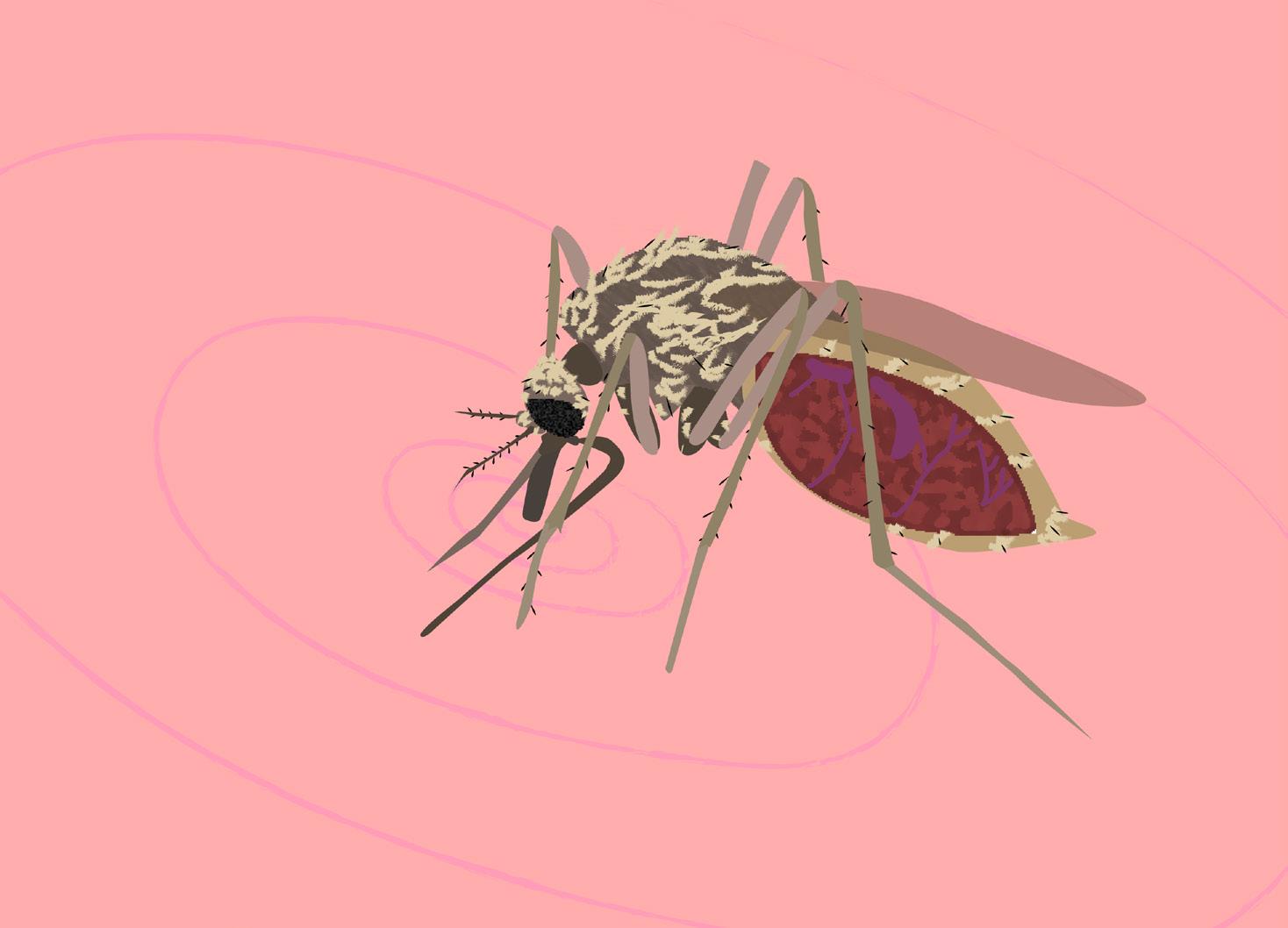
strategies are being researched.
“The conventional methods of treating malaria such as drugs or insecticides [are] very expensive and labor intensive,” said Gregory Lanzaro, a professor in the Department of Pathology, Microbiology and Immunology. “That got us thinking about using the mosquito itself to produce a cost-effective and sustainable way to control malaria.”
For the past 30 years, researchers have studied the usage of gene drive technology to stop the spread of malaria. The idea is to create genetically engineered mosquitoes (GEM) that are either resistant to carrying the malaria parasite or that fail to reproduce, which would result in the reduction of the mosquito population. The gene drive technology relies on the use of the Cas-9 enzyme, which ensures the passing of the new modified genes onto offspring in the introduced population.
BY ALMA MECKLER-PACHECO science@theaggie.org
Concerns over the success of this technology arose due to the high sequence variation in the genomes of mosquito species. The Cas-9 enzyme requires a specific 23 base pair stretch of target DNA to be effective.
“For the GEM strategy to work, it is essential to have a sequence of DNA that is identical in almost every specimen of the target population,” said Hanno Schmidt, a postdoctoral researcher, via email.
Researchers began to question the viability of this technique, as many thought wild mosquitoes might not have the specific target DNA, which could result in individuals carrying the variation resistant to the drive.
“People were worried about using Cas-9 because mosquito genomes are very polymorphic and have lots of base pair substitutions,” Lanzaro said. “The concern was that it would be hard to find a 23 base pair sequence that didn’t have some variation which could lead to the Cas-9 not working.”
A recent study conducted by entomologists in the Vector Genetics Lab, led by Lanzaro, alleviates these concerns, as it proves the success of the technology despite the high variation in the genomes across mosquito species.
The lab determined that 90% of all protein-encoding genes include at least one Cas-9 target site. The researchers obtained these results through examining the genomes of three different species of mosquitoes. A total of 1,200 whole genome sequences collected by the lab and the Ag1000g Consortium, a research project being conducted by MaleriaGen, were examined for potential target sites. This large collection of genome sequence data allowed the researchers to dismiss concerns over the potential failure of gene drive.
“Sunlight is known to inactivate a lot of viruses, [and] it’s not good for envelope viruses like SARS,” Coil said. “Heat inactivates a lot of viruses including SARS, [although] it depends on what the transmission looks like.”
Researchers agree that increasing ventilation and sunlight levels in existing buildings could prevent disease transmission; however, negative pressure and isolation are more effective at mitigating viral spread in a building when an infected individual is already present.
“If you put a fan in the window, pushing [air] out, you would be drawing air from the house into that room and then [outdoors],” Coil said. “That would be negative air pressure.”
Though more research on the relationship between viral transmission and the built environment is in progress, scientists have already identified a few factors as having significant effects on transmission within the built environment.
“In general, the built environment plays major roles in transmission of a huge number of infectious diseases,” Eisen said. “Examples of issues to consider include filtration, relative humidity, temperature, cleaning, surface materials, water storage, and more.”
With confidence in the success of gene drive, further progress can be made in this field. The Vector Genetics Lab works closely with UC Irvine’s Malaria Initiative, which leads a population modification approach to treating malaria. The goal is to use gene drive to stop mosquitoes from transmitting the malaria parasite.
“Professor Anthony James and his team at UC Irvine advance the laboratory strain of the modified mosquitoes,” Schmidt said via email. “The Vector Genetics Lab currently investigates natural populations at African oceanic islands that are potential targets for initial field release trials.”
Leading the field application aspect of the project, the Vector Genetics Lab selected two African island nations, the Republic of São Tome and Príncipe and the Union of Comoros, as potential field sites. The research is in the initial stages as they work to understand the population genetics of the mosquitoes native to the islands.
“On the science side, we need to have a very thorough understanding of the mosquitoes on the islands and their ecology,” Lanzaro said. “Our goal is to understand mosquito biology from the perspective of malaria transmission in a broad site.”
“One thing that we’re continuing to think about is how can we expand the reach of our conference outside of Davis, outside of Sacramento, outside of even California maybe,” Nuñez said. “And I think when we do that, we include more people that support our students and when we can include more people, that’s always a positive.”
Although the research conference was harder to organize than ever before, it has also never been more relevant, as highlighted in Chancellor Gary May’s Undergraduate Research Conference welcoming statement.
TELEHEALTH CONTINUED FROM PAGE 2
We take those services really seriously and a lot of our patients choose not to go to other providers because they get mistreated. We want to serve them.”
Undergraduate volunteers, however, are not involved in the clinic’s in-person work given health restrictions and patient safety, she said. They are working to make face coverings and will be inputting patient records when COVID-19 tests get administered through the outreach clinic. Barriers to accessing telehealth
The decision to keep Joan Viteri open for accessibility reasons addresses a major shortcoming with telehealth: Technological barriers can prevent prospective and current patients from receiving care.
CalMatters’ Ana B. Ibarra and Elizabeth Aguilera said telehealth was initially meant for inner-city and rural communities, where access to a clinic is less guaranteed.
Those communities are where student-run clinics operate and serve. Video visits bypass one barrier to accessing healthcare: transportation. Still, not everyone in those communities has ready access to the Internet, phones or computers. Informing patients about changing services has been one challenge for student-run clinics. Though clinics have been advertising changes to their schedule and updates to services on social media, Aguirre said the clinic has seen a reduction in current patients.
“We see up to 25 to 35 patients during our normal Saturday clinics — now it’s anywhere between 10 to 20,” he said. “Technology isn’t always our patients’ forte because a lot of them are on the spectrum and older. While we have a sign at our physical location, only a few patients will see our clinic number and information when they drive by.”
He said volunteers have started calling patients who hadn’t come in recently to both check-in and update them on the clinic’s services.
Language can also be a barrier to helping patients. Paul Hom Asian Clinic, Shifa Clinic, Bayanihan and Clínica Tepati are geared toward helping the Asian and Pacific Islander, South Asian and Muslim, Filipino and Latino populations specifically.
Hannah Pan, one of the undergraduate co-directors at Paul Hom, said she began volunteering at Paul Hom because she was excited to use the language she grew up speaking at home to break down linguistic barriers to care.
“I think a lot of us take for granted the fact that we can walk into a doctor’s office and immediately address our health concerns,” she said via email. “For a lot of our patients, language and culture [...] prevent them from being able to communicate effectively with their doctors.” The clinic offers services in six languages: Cantonese, Mandarin, Korean, Taishanese, Vietnamese and Hmong.
Patient advocates — undergraduate volunteers — at Paul Hom are providing translation services, getting on three-way calls with a patient and a medical student or preceptor during health consultations, the only service the clinic is currently providing beyond medicine refills. Daragahi said that in the process of transitioning to telehealth, not having undergraduates coming into Joan Viteri created a linguistic gap in care.
“A lot of our patients are Spanish-speaking and a lot of our undergraduates provided translational services,” she said. “Our medical students [working] right now don’t speak Spanish, but we’ve had some of our undergraduate volunteers sign up to provide those services in the future, so hopefully that gap will be remedied soon.”
“Our scholarship addresses some of society’s most critical challenges, including climate change, feeding the world, and the sustained the health of all living beings,” May said. “We’re living through extraordinary times, the need for research collaboration and innovation couldn’t be greater.”
BEARDEATH CONTINUED FROM PAGE 4
McNerney said that he wasn’t sure who dubbed the deceased bear “Gilligan” since his department tends to avoid nicknaming wildlife. He guessed that social media users had named it after the 60’s sitcom Gilligan’s Island, upon learning about the bear’s chosen island habitat. Bear sightings are typically rare in Davis. However, in June of last year, another young black bear was successfully captured and released after wandering into the Arboretum, UC Davis News and Relations reported. That bear had likely been kicked out of his original habitat after his mother had new cubs, according to Josh Bush of CDFW.
Sometimes they get lost and wind up in places that are less desirable for bears and people,” Bush told Campus News.
“Gilligan” probably wound up in Davis under similar circumstances, McNerney said, with a pregnant mother forcing the young bear off her territory to make room for her new offspring.
While Joan Viteri’s outreach clinic remains open to serve the unsheltered population, Willow Clinic, which primarily serves people experiencing homelessness, has partnered with several Sacramento organizations to ensure patients are aware of the service changes.
Jeremy Hockenberry, who leads the Smoking Cessation Committee with Willow, said their organizational partners, such as Sacramento Street Medicine, have been delivering care kits with flyers informing the unsheltered about the recent change in services.
“Within the last week, our preceptor has allowed us to have new patients, but it was at first difficult for patients to understand we wouldn’t be at Salvation Army [where we currently give services],” he said.
To ensure patients can get connected to resources or make it to local pharmacies, Willow volunteers have been organizing rideshares to take patients to those locations. They currently offer medicine refills, referrals for social services and COVID-19 patient education through the technology at the Salvation Army. Patient reaction, looking ahead
Hockenberry said that recently, more patients have been understanding the telehealth protocol shift.
“They’re excited we’re still here to support them and that they get to have their meds refilled,” he said. “Some of them haven’t been able to make it to the clinic in months or used their meds consistently.”
Positive patient reactions to student-run clinics’ shift toward telehealth have been common.
Pan said via email that Paul Hom’s patients seem very receptive toward the novelty of telehealth.
“Patients are very comfortable with addressing their concerns over the phone and still talk to us in the same way they would normally do in an in-person visit,” she said. And Yuson said Bayanihan’s patients have been responding similarly.
“When I called patients to check up on them and see if they wanted to reschedule, they were so understanding of the situation — they even checked up on me,” she said. “It was a humanizing experience that really broke the barrier between being a coordinator to the clinic community and being a person.”
She said Bayanihan volunteers also provide healthcare services and entertainment to Filipino veterans, who she referred to as veteranos, and in lieu of monthly visits to the Filipino War Veteran Legion’s events, volunteers continue to contact veteranos.
“It’s not necessarily anything specific on the healthcare end,” she said. “We just wanted to make sure they had all the info and resources they needed, but also to check up on them and ask about their families, their work, anything they want to talk about.”
Whether or not the clinics must continue telehealth during Fall Quarter, Aguirre said it was important for volunteers to remember their respective clinic’s mission and why they continue to provide service.
“Something I always tell folks at Tepati is that we should work within a community framework and that Tepati was built on the foundations of helping the Latino community — that’s the mission that really set this clinic, to fill this gap in healthcare,” he said. “Tepati belongs to everybody. Everybody puts in their effort.”
DOUBLESTANDARD CONTINUED FROM PAGE 14
Young stars really can’t win, no matter what they do. Dancer and performer JoJo Siwa has been subject to internet bullies for years now because she caters her image to her predominantly young audience. Often compared to Brown, people criticize the 19-year-old star for wearing colorful bows and “childish” outfits.
Singer Billie Eilish rose to fame at the age of 15 with her song “Ocean Eyes.” She became known for wearing baggy clothes that hide her frame in order to avoid being sexualized in the way so many young stars before her have. This alone sparked controversy and dialogue in the media, with many shocked that a child would not want their body to be objectified. Even more controversy arose recently when Eilish posted a picture of herself in a swimsuit.
“Mom says, ‘it’s time for you to go, you’re on your own, I’ve got to defend my territory and feed your brothers and sisters’” McNerney said. “So, she then will start pushing those ‘older youngsters’ off-territory.”
The recently evicted young bears must then find a new habitat, McNerney said. Often the surrounding area is already occupied by other bears, however, pushing the bear to move further and further in its search for a new home. Sometimes, they encounter human-made or natural physical barriers, forcing them to travel down available corridors — such as irrigation channels or roadways — which can eventually leave them deep into human territory, McNerney said.
“‘It was trending,” Eilish said in an interview with Dazed. “There were comments like, ‘I don’t like her anymore because as soon as she turns 18 she’s a whore.’ Like, dude. I can’t win. I can-not win.”
MURDERHORNETS CONTINUED FROM PAGE 16
Behaviorally, this species shares characteristics with other social wasps.
“[Their antivenom stinging mechanism to protect their hive] is not something specific to the species, it’s something that you see across social insects,” Field said. “They’re not meaner than others, they’re just doing their job.”
The most focused-on behavior of these giant hornets is their predation of honey bees, despite the fact that other insects, like yellow jackets, prey upon them as well. Asian giant hornets have a particularly gruesome way of ambushing a honey bee colony, Field said. After decapitating honey bees, these hornets remove their thoraxes and feed them to their larvae.
Even though western honey bees are not native to the U.S., they have been living in North American environments for so long that they are now essential agricultural pollinators, said Gigi Melone, a third year entomology major.
“[Asian giant hornets’] effect would be on the crops that use honey bees to pollinate them,” Field said. “This is a huge, multi billion dollarindustry here in the United States so the concern really is economic and less ecological.”
MOSQUITOES CONTINUED FROM PAGE 16
An equally important aspect of their work on the island is community engagement and education. The team works closely with the National Malaria Control Programs of each field site.
“In the next several years there is a lot of education that needs to happen in the highest level of the countries,” said Ana Kormos, the community engagement manager for UCI’s Malaria Initiative. “At the same time, really building some strong relationships with different groups within the countries on how they feel about malaria and how they might respond to a field trial.”
The lab produces a large amount of educational materials on gene drive technology and the research process, such as what a GEM is and
WBBSEASON CONTINUED FROM PAGE 18
In addition, Gross has been using Zoom to conduct team building sessions with the players. The team generally does a variety of these activities throughout the year that reinforce the core values of the program, as well as help build relationships between the team members. Usually these activities would be done in person, but the team has had to adjust to a new situation.
“Usually we would do once a week where we would meet with the team and do all different kinds of activities and have team discussions,” Gross said. “Sometimes, they’re just a chance for us to get to know each other better. Other times we’re discussing something that we think is really important to our team. Other times, we’re just playing some games and having fun. But, we’re trying to get creative and do some of those things virtually.”
As the team continues to process the end of an incomplete season, its members are also beginning to look to the future. Although it is difficult for the athletes to practice right now since some do not have their own basketball hoops and many public facilities are closed to the public due to health concerns, Gross has been workwhy these countries may want to consider implementing GEMs. This helps inform and build relationships with the countries as they decide whether or not to approve the release of GEMs.
Their gruesome honey bee attacks may be why people use the term “murder hornets” to describe the species. Field said she is unsure how this name originated but guessed that it could have been coined from a translation of a Japanese common name, or by media outlets in the U.S.
“I think they picked [the name] to draw up hysteria and to sensationalize this insect,” Field said. “It was pretty effective at doing that. It’s crazy because they’re not going around murdering people.”
Despite the negative coverage regarding the Asian giant hornet, it always excited Melone to see insects in the news. Both Melone and Field hope the news about the hornets will spike interest in insects.
“I think if this has made people curious aboutinsects, it’s a great time to start learning about insects, because they’re all around us, especially in spring,” Melone said.
COVID19WEBINAR CONTINUED FROM PAGE 18
“The most important thing is that even though cats, and to a lesser extent, dogs, can be infected through contact with infected people, pets are not the drivers of transmission of SARS-CoV2 – human to human transmission is,” Sykes said via email. “People should continue to enjoy the benefits of the human animal bond, especially at such a stressful time. It remains possible that we will see evidence of pet to human transmission, but people are much, much more likely to get infected by going to the grocery store or a restaurant. The finding of animal infections needs to take into account the ‘big picture.’”
After the panelists gave brief presentations, Leal introduced Maheshwari to share his testimony of being diagnosed with and recovering from COVID-19. Maheshwari explained that he had contracted the virus from a patient despite wearing the necessary personal protective equipment. He described the worsening of his condition and the emotional toll he experienced when it had seemed his chances of survival were slim.
Maheshwari advised people to visit the hospital if they recognize any symptoms rather than
“Even if we are not able to release them at these islands, we would still have a lot of information on the malaria transmission on these islands for them to use in a more conventional way,” Lanzaro said.
While no GEMs have yet been released, the potential benefits of this technology are immense. As a cost-effective and highly efficient control tactic, gene drive could greatly reduce the spread of not only malaria but many other mosquito transmitted diseases such as zika, dengue fever and yellow fever.
ing with her team and offering optional strength and conditioning workouts.
“We’re moving on to: How do we prepare ourselves as best we can for next season? And one thing in our program that’s really important that we talked about all the time is having really strong relationships, player-to-player, player-tocoach, [and] coach-to-coach,” Gross said. “Because we can’t be working on our physical game right now, that’s something that we’re trying to do — work on building the foundation for our team heading into next season. Really strengthening our relationships, both with the players on our team and the incoming players. We’re really trying to be very intentional with that aspect of our team right now.”
In addition to looking out for the incoming athletes, Gross and other members of the coaching staff have remained in touch with the current seniors, offering them support, words of encouragement and advice for those interested in continuing their basketball careers post-graduation. The team as a whole is continuing to move forward and is looking toward next season.

thinking they can recover on their own. Leal then relayed questions asked by viewers to each of the researchers, addressing topics such as reinfection and the use of antibiotic tests. One topic that was frequently asked about was the utilization of homemade masks and their effectiveness.
“Wearing masks can reduce the spread of COVID-19 by reducing the largest droplets from sneeze and cough,” Hsieh said. “However, smaller droplets or aerosol from speaking or breathing can travel far for minutes and are too small to be blocked by homemade masks. Keeping distance is still critical.”
Leal concluded the event by thanking all of the panelists for their time and thanking health care workers for their continued work fighting COVID-19. Leal added that this symposium also took the efforts of information technology experts and communication specialists, as well as his family members, to make the event run smoothly.
“From what I heard from attendees, they say it was helpful,” Leal said. “If so, mission accomplished.”
With the cancellation of this year’s Big West conference tournament, the UC Davis women’s basketball team has had to adjust to a season cut short. The team cruised through the regular season, winning their fourth consecutive conference championship and had been on its way to defend its conference tournament title when Big West officials made the decision to cancel the remainder of the competition due to concerns over the spread of COVID-19.
After winning the regular season, the Aggies had earned the top seed and a double bye in the tournament and, as a result, did not have a game scheduled until the semifinal round on March 13. Although the tournament had started a few days prior on March 10, the team was still in Davis at the time, practicing and looking on anxiously to see who it would be playing against.
After the conclusion of the quarterfinals on March 11, UC Davis was set to take on eighth-seeded Cal Poly. The following day, the Aggies were practicing for the tournament and getting ready to board the bus that would take them to Anaheim when they received word that the remainder of the tournament was cancelled.
“It was definitely heartbreaking,” said Head Coach Jennifer Gross in a phone interview. “I won't say it was shocking because that morning, a number of conference tournaments were starting to get cancelled and so we were wondering if that might happen. And we understood. We understood that it was the best thing for everybody's health, but it was really heartbreaking.”
Gross relayed the message to the players as soon as she heard the news, and she said that although the decision was understood, there were definitely some tears. For the team’s three seniors, the decision was especially devastating. After winning yet another regular season conference BY PRIYA REDDY sports@theaggie.org The UC Davis women's basketball team celebrates becoming the 2020 Big West Conference champions after defeating UC Riverside at the Pavilion on Feb. 29. (Photo by Justin Han / Aggie)
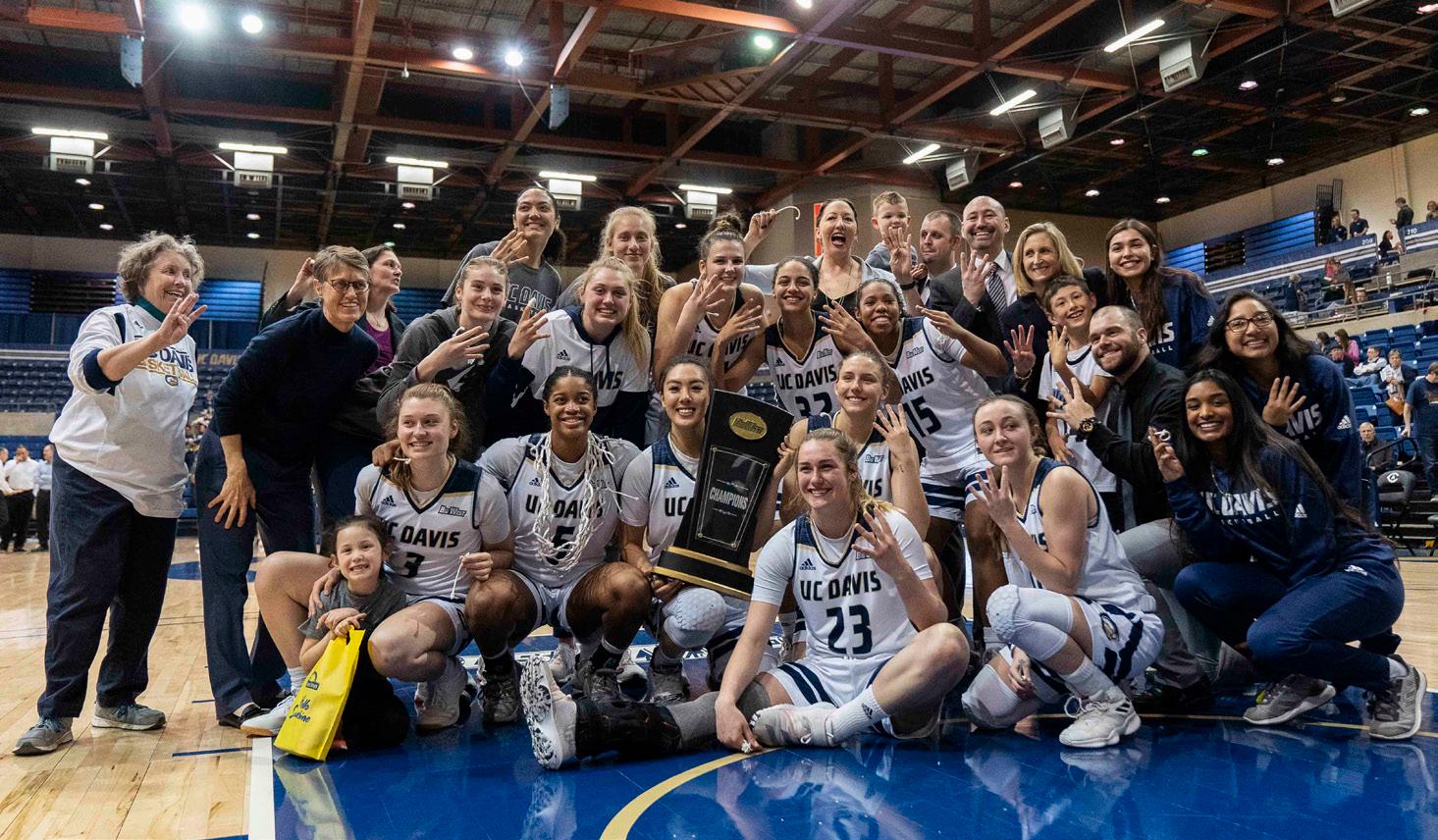
championship, the seniors were looking forward to playing in the conference tournament as a way of ending their college careers. When senior forward Nina Bessolo initially heard the news, she was in shock.
Bessolo described feeling “numb” and looking around to see people in tears when the news was announced in an email. Later, Bessolo recalled feeling “frustration, anger [and] sadness” while still being understanding of why the season had to end. These feelings all occurred with the realization that the team members “had worked so hard [...] just for it to end like this.”
“It was during one of our practices and at the time I was so shocked that I fel [sic] numb.The reaction from the people around me was tears which was completely understandable,” Bessolo said in an email. “We had worked so hard for this momeny [sic] just for it to end like this. My reaction a few days later was frustration, anger, sadness and understanding.”
For Bessolo, the realization that, as a senior, her time playing with the other members of the team with whom she had forged tight bonds had come to such an abrupt end was especially saddening. After injuring her thumb earlier in the season, Bessolo had been working hard to get back on the court. Having to end the season without being able to showcase everything she had been working for was frustrating. Despite these feelings, she was also understanding of the situation and that continuing to play would have been putting others at risk.
Redshirt-senior guard Katie Toole also had a hard time processing the tournament’s cancellation and the abrupt end to the season. A transfer from Utah State, Toole was a major player for the Aggies in the 2019-2020 campaign and ended this season ranked among the top 100 in the NCAA for field goal percentage — 60th with a 51% rate in 29 games. Toole had been looking forward to playing in the championship game this year and was devastated to hear about the cancellation.
“I have never played in a championship game before,” Toole said via email. “We have gone to the championship game but I didn't actually get to play any minutes in those games. And I thought this season would be my year. It was really hard to wrap my head around the fact that I may never get that chance. The whole team was really distraught and there was a somber feel in the locker room after practice. We were ready to go down and win another championship, and now we don't even get the chance.”
KIYOMI WATSON / AGGIE
NCAA TAKES NEXT STEP IN MOVE TO CHANGE NIL GUIDELINES BAY
Board releases 31-page plan outlining recommendations for athletes, schools
In October of 2019, the National Collegiate Athletic Association (NCAA) Board of Governors announced its decision to begin allowing student-athletes to be compensated for their own name, image or likeness (NIL). In the weeks and months that followed the announcement, many questions remained, including how to ensure these new rules would not create an unfair imbalance in collegiate athletics.
On April 17, the NCAA finally provided some additional clarity on how it planned to move forward with “modernizing” NIL rules. In its 31-page “final report and recommendations” document, the NCAA Board of Governors Federal and State Legislation Working Group outlined the basic guidelines it planned to use in crafting its new NIL rules.
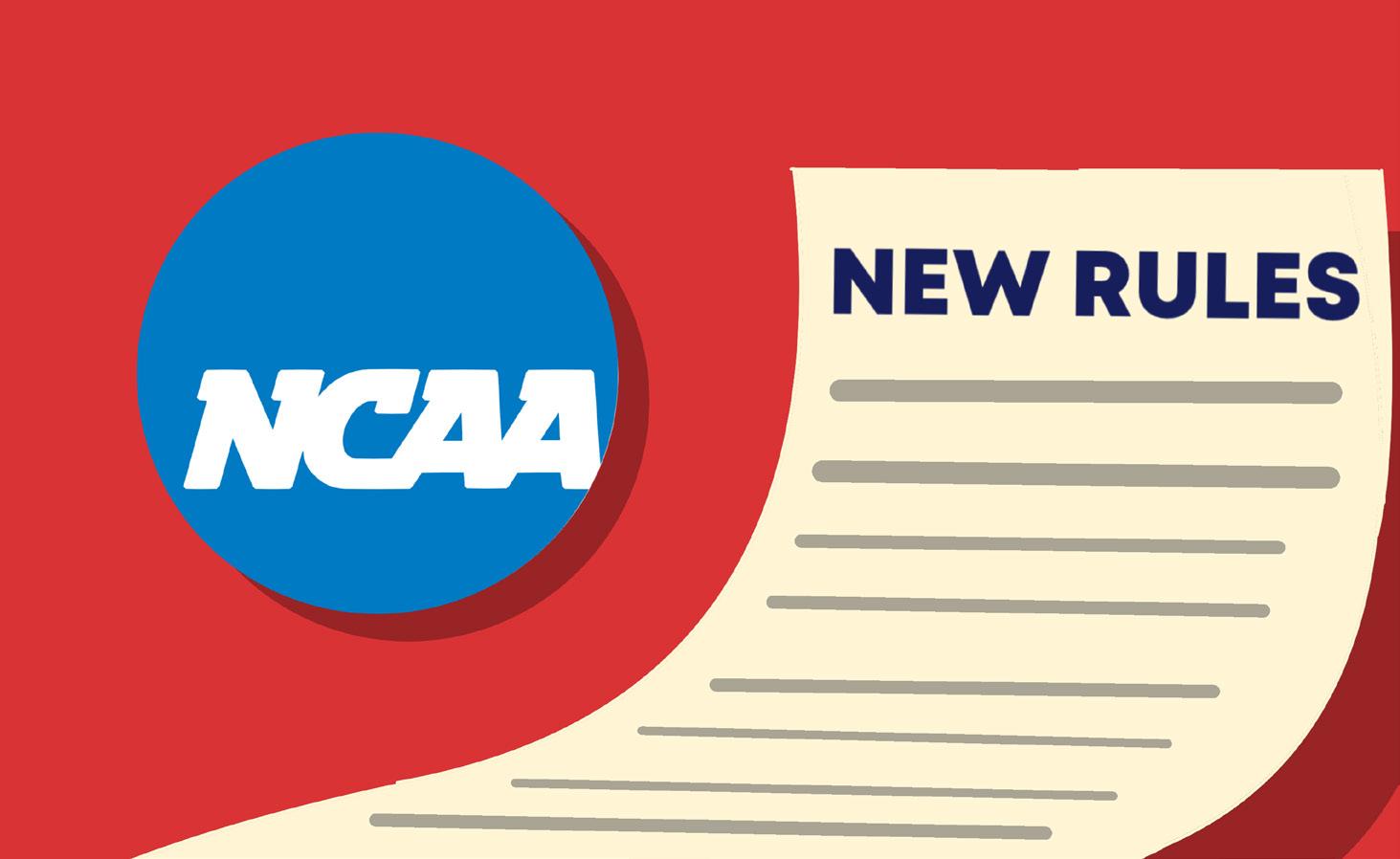
BY OMAR NAVARRO sports@theaggie.org
Student-athletes will now be able to take advantage of their own success and marketability. They will have the opportunity to be paid for their social media influence, appearing in commercials, giving athletic lessons, holding autograph signings and more. Athletes that enter college with a national following, or develop one during college, will be able to capitalize off that by seeking out paid opportunities — but many believe that the majority of athletes will receive the bulk of their endorsements locally.
Schools in any pre-existing NIL negotiations or activities will be excluded from this. While student-athletes will continue to be a part of their respective school’s program, they are not permitted to be paid by the universities themselves or be classified as employees of said schools. Colleges, universities and their athletics departments are to play no role in the student’s activities regarding seeking compensation for their NIL.
Part of the difficulty that both Bessolo and Toole have had with adjusting to the new reality is the isolation and the inability to be with the team. Both players found a home with the team and were able to bond with their teammates, and not being able to see them or play with them has hit hard.
“Some of my most memorable moments of my basketball career was traveling with my teammates,” Bessolo said. “I loved joking and fooling around with them on the bus, in the hotel rooms, and at meals. I am going to miss playing with them very much.”
Team members were used to seeing each other everyday, but when the season ended and classes at UC Davis transitioned to the virtual format, many players decided to go back to their respective hometowns.
“It has been weird adjusting because as soon as we heard the news many of my teammates went home,” Toole said. “It is strange going from seeing these people everyday to not at all within a few days. It has affected my future plans [too] because I am wanting to play overseas and many teams aren't even sure if they are going to be able to have a season next year let alone take on new players.”
Despite being physically separated, the players are still making efforts to stay in touch with each other. Team members regularly text one another and make use of a variety of social media platforms, including snapchat and instagram, to stay in contact.
WBBSEASON on 17
Another major recommendation set out by the NCAA states that a student-athlete is not allowed to show any signs of affiliation, like a school or conference logo, when conducting NIL activities. This allows the NCAA and its member organizations to further distance themselves from such dealings.
Opponents of new NIL guidelines have been concerned about the nature of possible student-athlete deals, as some say they could be used to create improper incentives for certain players or programs to sway a recruit away from another school. But the NCAA emphasized that these potential deals will be completely separated from athletics.
“Any compensation received by student-athletes for NIL activities represents a genuine payment for use of their NIL, and is not simply a disguised form of pay for athletics participation,” the report reads. “Schools or boosters are not using NIL opportunities as a recruiting inducement.”
These recommendations may seem cut and dry on paper, but in reality, the NCAA will likely have a difficult time keeping track of recruits and ensuring that NIL deals do not have a direct impact on a recruit’s decision. Especially when it comes to well-known, power five programs, there are obviously more opportunities for student-athletes to capitalize on their NIL at these schools compared to others.
“It is representative of progress in economic freedoms and rights for student-athletes, which I think is very positive,” said UC Davis Director of Athletics Kevin Blue in an email. “There are a number of granular details that will still be worked out.”
Although these rules seem to favor schools with bigger and more lucrative athletic programs — football in particular — that doesn’t mean that similar opportunities for student-athletes are nonexistent at schools where athletics are on a comparatively smaller scale.
On April 14, UC Davis held its second virtual COVID-19 symposium to update the public about recent research being conducted across the UC campuses as well as to answer questions from viewers. Walter Leal, a distinguished professor in the Department of Molecular and Cellular Biology, moderated the event again after organizing the first symposium.
UC PRESIDENT THANKS UC RESEARCHERS FOR COVID-19 RELATED WORK AT UC DAVIS’ SECOND VIRTUAL COVID-19 SYMPOSIUM
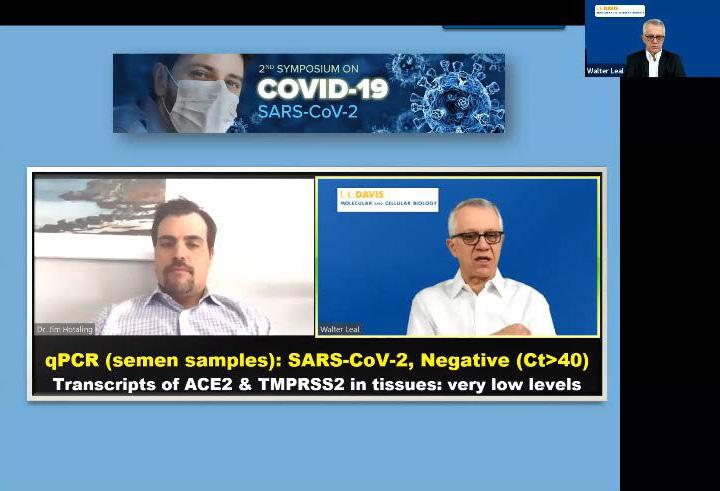
Due to his involvement in research during the Zika virus pandemic, Leal received many questions when the current pandemic began. Fueled by a love for learning and former experience with hosting large events, Leal decided to gather people who could answer these questions. "There are many unknowns about this new BY MICHELLE WONG science@theaggie.org Researchers, medical professionals across UC system share recent work, answer questions regarding novel coronavirus virus and how it is transmitted and prevented, etc," said You-Lo Hsieh, a distinguished professor and chair of the Department of Textiles and Clothing, via email. "As new scientific data and analyses become available, symposiums like these organized by UC Davis are effective in relating the most current knowledge to the public."
“The visibility for student-athletes at some of the FBS programs is certainly higher, therefore the earning potential […] is higher,” Blue said. “But I would not underestimate the earning opportunities that will present themselves locally. Our intention is to educate our student-athletes as to how they can best optimize their earning potential.”
How some schools will go about adapting to these new rules — which will go into effect at the beginning of the 2021–2022 academic year — remains to be seen, but UC Davis Athletics seems to be committed to helping its student-athletes. Blue, at least, sees this as a possible learning experience for student-athletes, rather than a hindrance to their academic performance.
“There are people who believe increased commercial rights […] will have an impact on academics, I just don’t believe that at all,” Blue said. “In fact, these commercial experiences will help student-athletes become more sophisticated about how the real and business worlds work.”
A major takeaway from the NCAA’s report is the organization’s continued attempts to separate itself from student-athletes and underscore the fact that the students aren’t employees of the NCAA or its member universities. While the NCAA is loosening its financial hold over these athletes, it still emphasizes that all new NIL rules must be made in congruence with its “core values, mission and principles.”
The plan on paper seems reasonable, as some student-athletes will finally be able to freely profit off of their own hard work and talent. How the NCAA will go about enforcing these rules, however, is still unclear, as many more details are set to be released in the near future.
Nonetheless, endorsement deals, social media influencing opportunities and much more will be at the disposal of college athletes across the country, as they will soon begin the new era of college athletics.
The symposium involved medical professionals such as Allison Brashear, the dean of the UC Davis School of Medicine; David Lubarsky, the vice chancellor of human health and chief executive officer for UC Davis Health; Emanual Mverakis, an associate professor in the Department of Dermatology at UC Davis Health; William Isenberg, the chief quality and safety officer for Sutter Health and Anoop Maheshwari, a doctor at Riverside Community Hospital. The full three-hour symposium can be streamed on the “'Biochemistry Channel” on Youtube.
The event opened with a statement by Chancellor Gary May who introduced UC President Janet Napolitano. In her welcoming address, Napolitano thanked faculty across the UC system for their efforts in researching COVID-19, highlighting undocumented students and faculty who are also contributing to these studies.
Among the panelists was Atul Malhotra, a professor of health from UC San Diego Health, who discussed the effects of COVID-19 on the respiratory system and its shared similarities with acute respiratory distress syndrome (ARDS). Malhotra warned that mechanical ventilators can be life-saving if set up correctly but deadly if not placed at the right settings.
Malhorta studies the antibody tocilizumab’s response to COVID-19-induced pneumonia. While the antibody has shown significant improvement in patients in terms of body temperature, oxygen saturation and oxygen inhalation, further tests and more data are necessary to confirm its effectiveness. "These symposia provide an excellent vehicle to disseminate knowledge," Malhotra said via email. "The information we receive through mass media often has some spin or interpretation based on political or other pressures. Having a frank discussion with questions and answers is a good way to keep people informed."
In the closing statements of his presentation, Malhotra spoke about the importance of randomized treatments and studies, as opposed to applying various medicines in hopes that one will act as a cure. In doing so, people are depleting supplies for patients who actually need specific medications for their health conditions. "Many people on TV recommend just trying various medicines in a haphazard way without any evidence," Malhotra said. "The use of medications this way makes it very hard for us to tell the truth. Also medications have costs and side effects so the use of medicines without evidence has important risk as well as possible benefits."
In addition to a discussion on clinical trials and prevention methods for humans, the concern of contracting COVID-19 from pets was addressed by Jane Sykes, a professor in the Department of Medicine and Epidemiology at the UC Davis School of Veterinary Medicine. COVID19WEBINAR2 on 17 The second UC Davis COVID-19 public awareness symposium took place on May 14. (Courtesy Photo)



